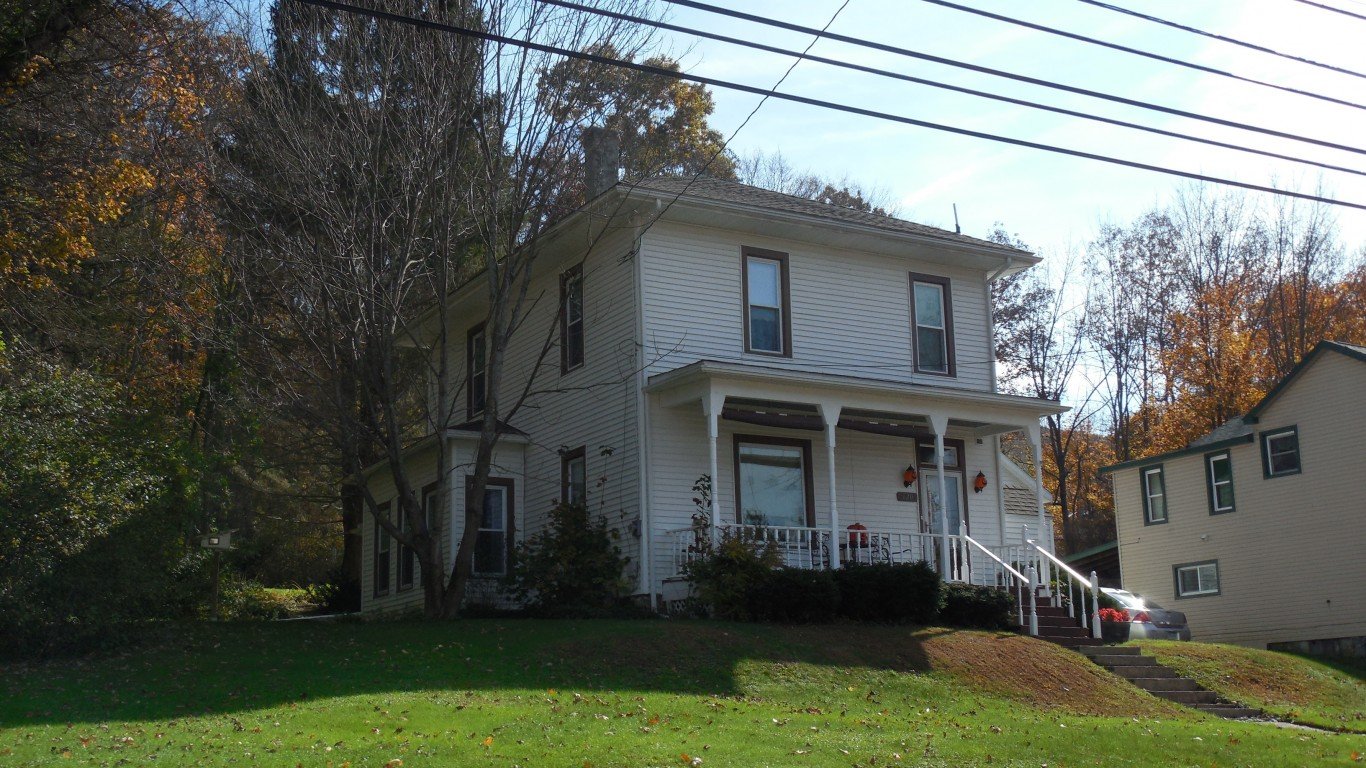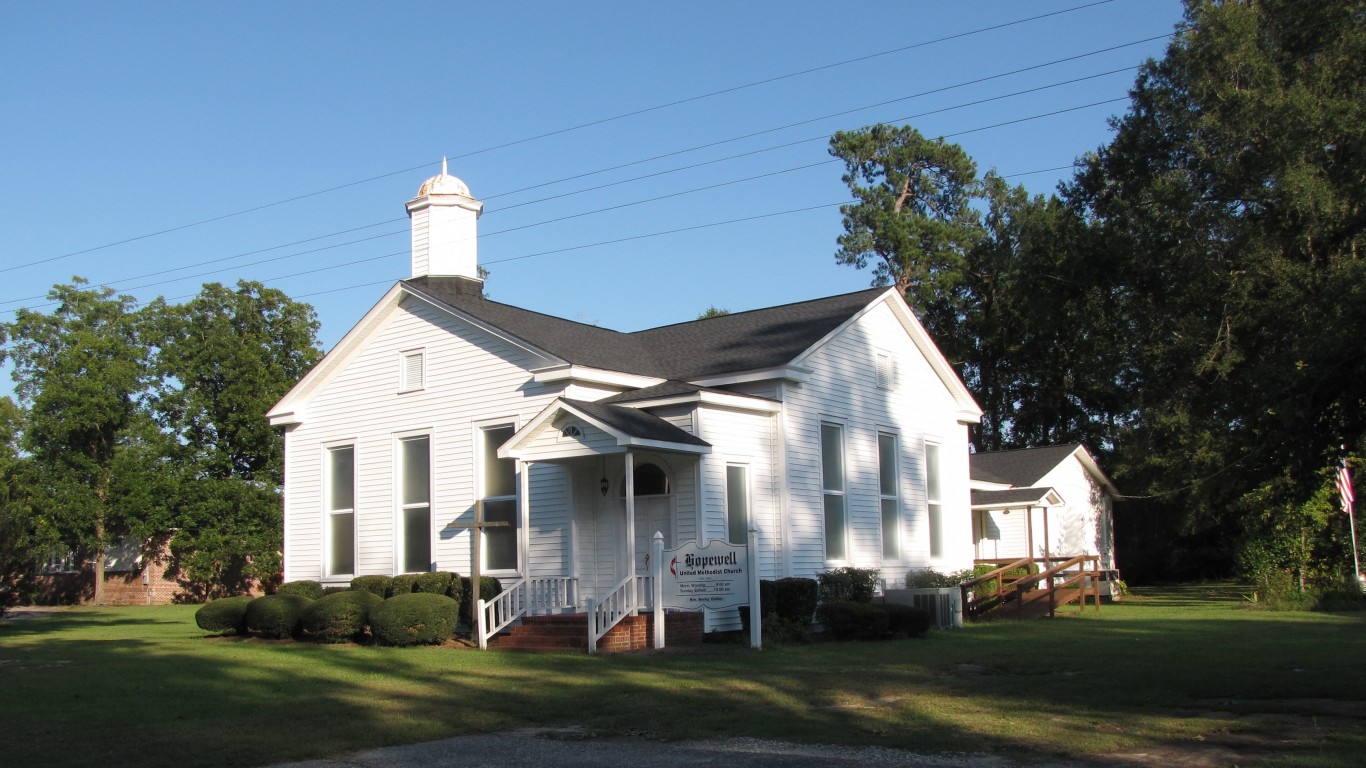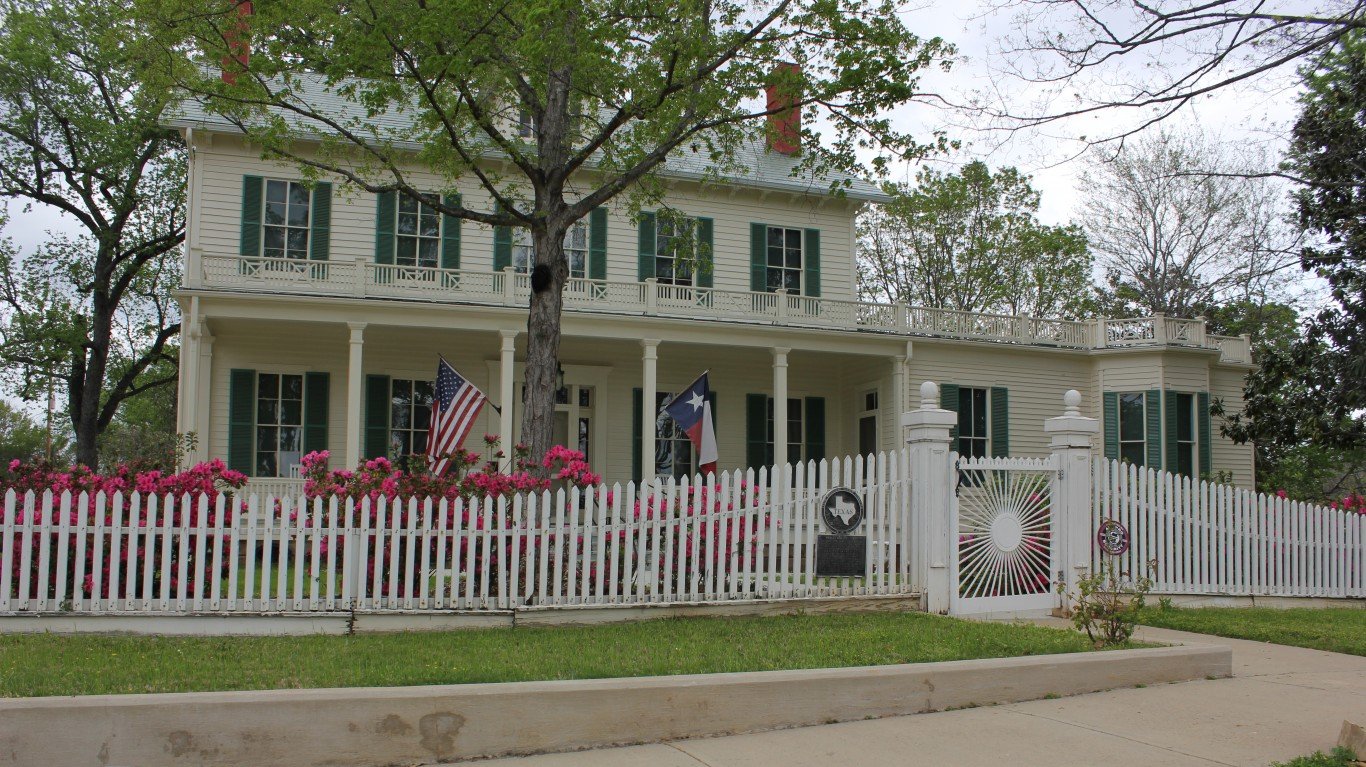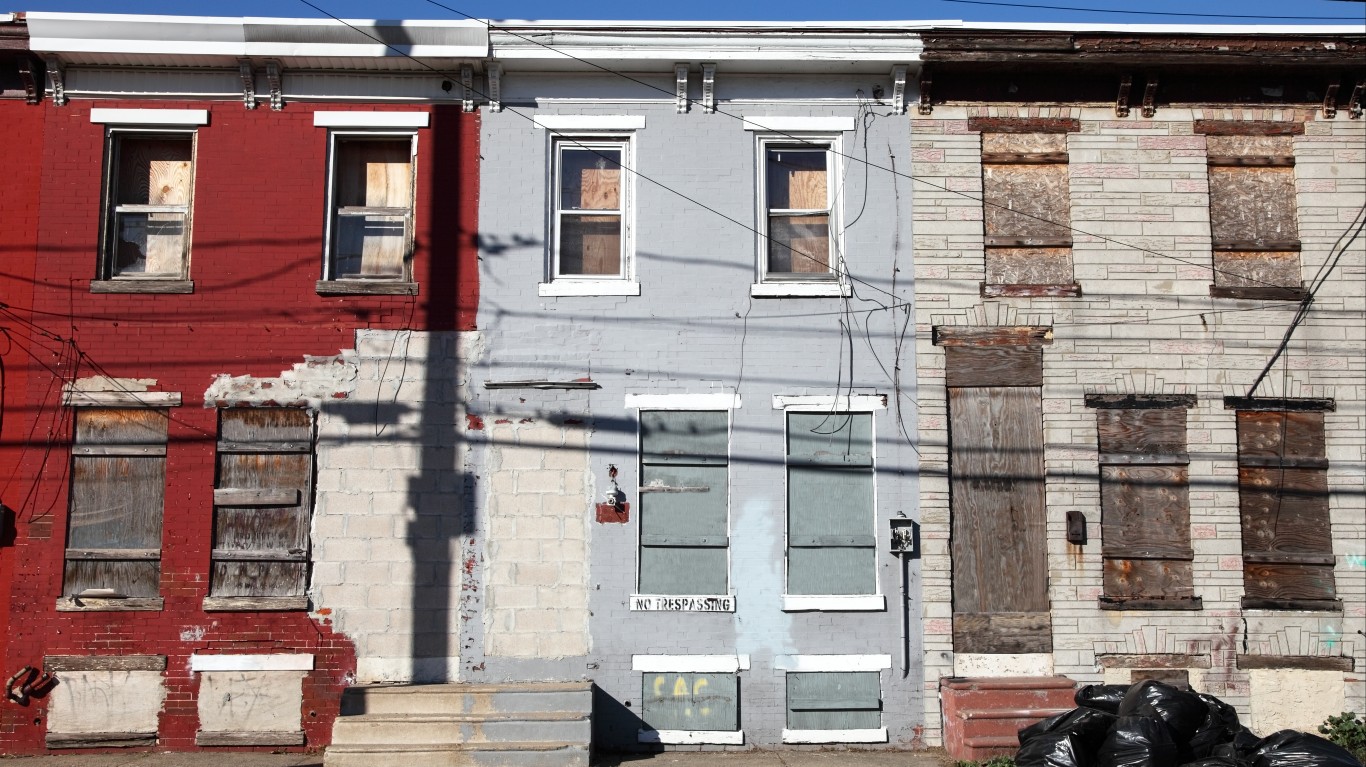

Most American households earn more than $62,800 annually, according to data from the U.S. Census Bureau. While it is one of the most prosperous countries in the world, the U.S. also has some of the worst income inequality. As a result, the national median income does not reflect the economic struggles of millions of Americans.
In nearly every state, there are counties or county equivalents where the median household income is well below the $62,843 national median. In half of all states there is at least one county where the median annual household income is less than $40,000. Using five-year estimates from the 2019 American Community Survey from the Census, 24/7 Wall St. identified the poorest county in every state.
While there are several notable exceptions, many of the counties on this list are relatively rural and far removed from major metropolitan areas that often serve as hubs of economic activity.
While much of the country is facing an unemployment crisis triggered by the COVID-19 pandemic, the job markets in the counties on this list have often been hit even harder than most other nearby counties. In 35 of the 50 counties on this list, the unemployment rate exceeds the comparable statewide jobless rate. Here is a look at the cities with the worst COVID-19 unemployment crisis right now.
It is no coincidence that many of the counties on this list are also home to relatively small college-educated populations. According to the Bureau of Labor Statistics, the typical worker with a bachelor’s degree earns $64,896 annually working full time. Meanwhile, workers with no more than a high school diploma earn just $38,792 per year. All but two counties on this list have a lower bachelor’s degree attainment rate than their respective state. Here is a look at the most and least educated states in the country.
Click here to see the poorest county in every state.
Click here to read our detailed methodology.

1. Alabama: Sumter County
> Median household income: $24,320 (state: $50,536)
> Poverty rate: 31.8% (state: 16.7%)
> Nov. 2020 unemployment: 4.1% (state: 4.0%)
> Adults with a bachelor’s degree: 21.6% (state: 25.5%)
> Largest place in county: Livingston
Sumter ranks as the poorest county in Alabama. With a median annual household income of just $24,320, it is one of only 10 U.S. counties or county equivalents where most households earn less than $25,000 a year. Sumter County residents are also nearly twice as likely as the typical Alabaman to live below the poverty line.
Incomes tend to rise with educational attainment, and lower-income areas are also often home to smaller shares of college educated adults. In Sumter County, just 21.6% of residents 25 and older have a bachelor’s degree or higher, compared to 25.5% of adults in Alabama and 32.1% of adults nationwide.
[in-text-ad]
2. Alaska: Yukon-Koyukuk Census Area
> Median household income: $41,413 (state: $77,640)
> Poverty rate: 25.4% (state: 10.7%)
> Nov. 2020 unemployment: 9.9% (state: 8.1%)
> Adults with a bachelor’s degree: 13.6% (state: 29.6%)
> Largest place in county: Fort Yukon
The typical household in Alaska earns $77,640 a year — about $15,000 more than the income the typical household earns nationwide. Though the state as a whole is wealthier than the U.S., not all parts of Alaska are high earning. In the Yukon-Koyukuk Census Area, the typical household earns $41,413 a year. Additionally, nearly 15% of area households live on less than $10,000 a year — more than three times the comparable 4.1% share across the state.
Lower-income areas often have job markets with limited employment opportunities. In Yukon-Koyukuk, about one in every 10 members of the labor force are unemployed, compared to 8.1% of the state labor force and the 6.4% national labor force.

3. Arizona: Apache County
> Median household income: $32,508 (state: $58,945)
> Poverty rate: 35.5% (state: 15.1%)
> Nov. 2020 unemployment: 12.6% (state: 7.6%)
> Adults with a bachelor’s degree: 12.3% (state: 29.5%)
> Largest place in county: Chinle
Apache County covers the northeastern corner of Arizona and much of the state’s border with New Mexico. The poorest county in the state, the county’s median household income of $32,508 is about $26,400 less than Arizona’s median household income of $58,945. Apache’s poverty rate of 35.5% is also more than double the state poverty rate of 15.1%.
As is often the case in low-income areas, Apache County has a relatively low bachelor’s degree attainment rate. Just 12.3% of county residents age 25 and up have a four-year college degree, less than half the 29.5% share across Arizona.

4. Arkansas: Lafayette County
> Median household income: $32,397 (state: $47,597)
> Poverty rate: 25.9% (state: 17.0%)
> Nov. 2020 unemployment: 8.4% (state: 5.7%)
> Adults with a bachelor’s degree: 15.8% (state: 23.0%)
> Largest place in county: Stamps
Arkansas is one of the poorest states in the country. The typical Arkansas household earns just $47,597 a year, about $15,200 less than the income the typical American household earns. In Lafayette County, the poorest county in the state, the typical household earns just $32,397 a year. In Lafayette, more than one in every four residents live below the poverty line, compared to fewer than one in five Arkansas residents.
A high school education is a prerequisite for most jobs, regardless of salary, and in Lafayette County, more than 20% of the 25 and older population have not completed high school. Across Arkansas, about 13% of adults have not completed high school.
[in-text-ad-2]
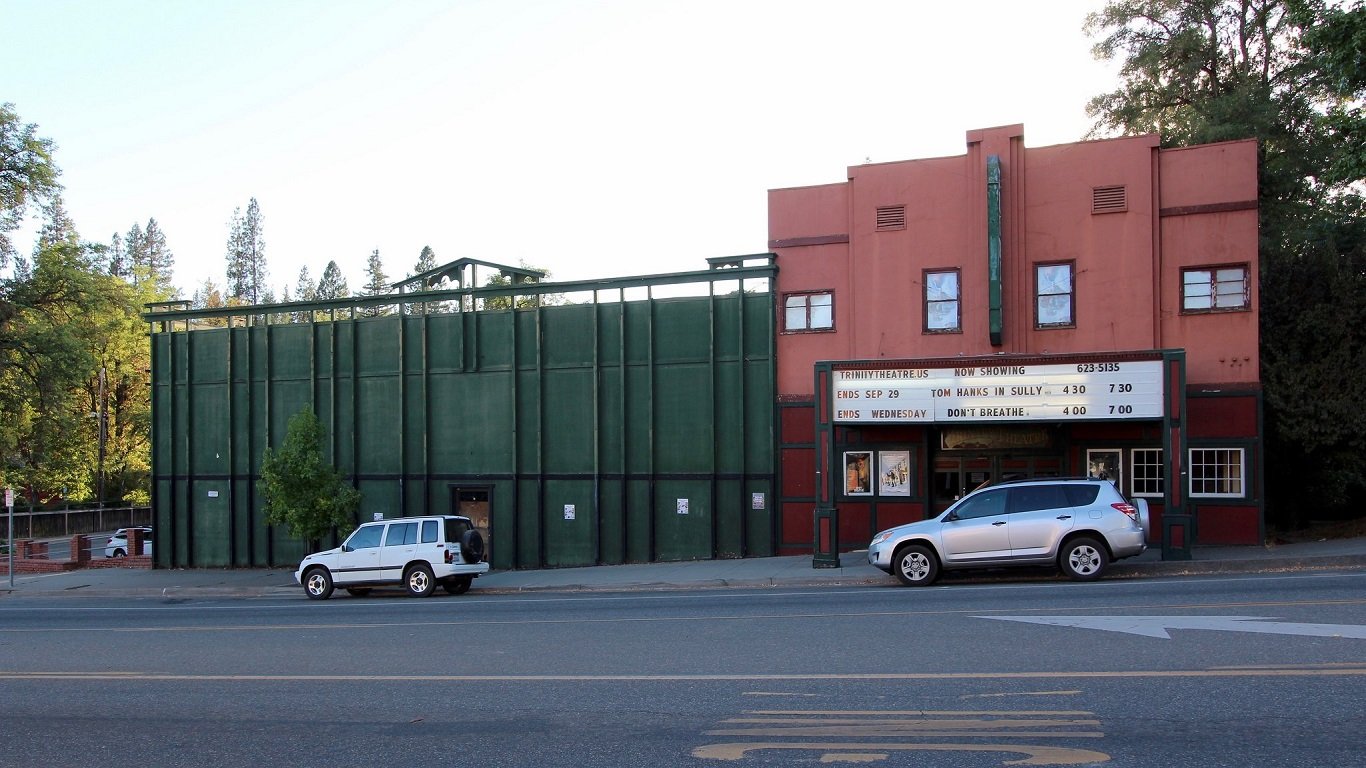
5. California: Trinity County
> Median household income: $40,846 (state: $75,235)
> Poverty rate: 19.0% (state: 13.4%)
> Nov. 2020 unemployment: 6.1% (state: 7.9%)
> Adults with a bachelor’s degree: 19.5% (state: 33.9%)
> Largest place in county: Weaverville
Trinity County, located in northern California, ranks as the poorest county in the state. The typical household in the county earns just $40,846 a year, well below the $75,235 the typical California household earns. In Tehama County, the second poorest county in the state, the typical household earns $44,514 a year, and in Santa Clara, the state’s wealthiest county, the median annual household income is $124,055.
Across broad populations, incomes tend to rise with educational attainment. In Trinity County, fewer than one in every five residents 25 and older have a bachelor’s degree. Across all of California, over a third of adults do.

6. Colorado: Bent County
> Median household income: $30,900 (state: $72,331)
> Poverty rate: 29.5% (state: 10.3%)
> Nov. 2020 unemployment: 4.7% (state: 6.2%)
> Adults with a bachelor’s degree: 11.4% (state: 40.9%)
> Largest place in county: Las Animas
Bent County, in southeast Colorado, has a median household income of just $30,900, the lowest of any county in the state, and less than half the statewide median income of $72,331.
Lower-income areas tend to be home to relatively small shares of college-educated residents — and Bent County is no exception. Only 11.4% of the 25 and older residents have a bachelor’s degree, well below the 32.1% share of adults nationwide. Meanwhile, Colorado is one of the best educated states in the country, with a bachelor’s degree attainment rate of 40.9%.
[in-text-ad]
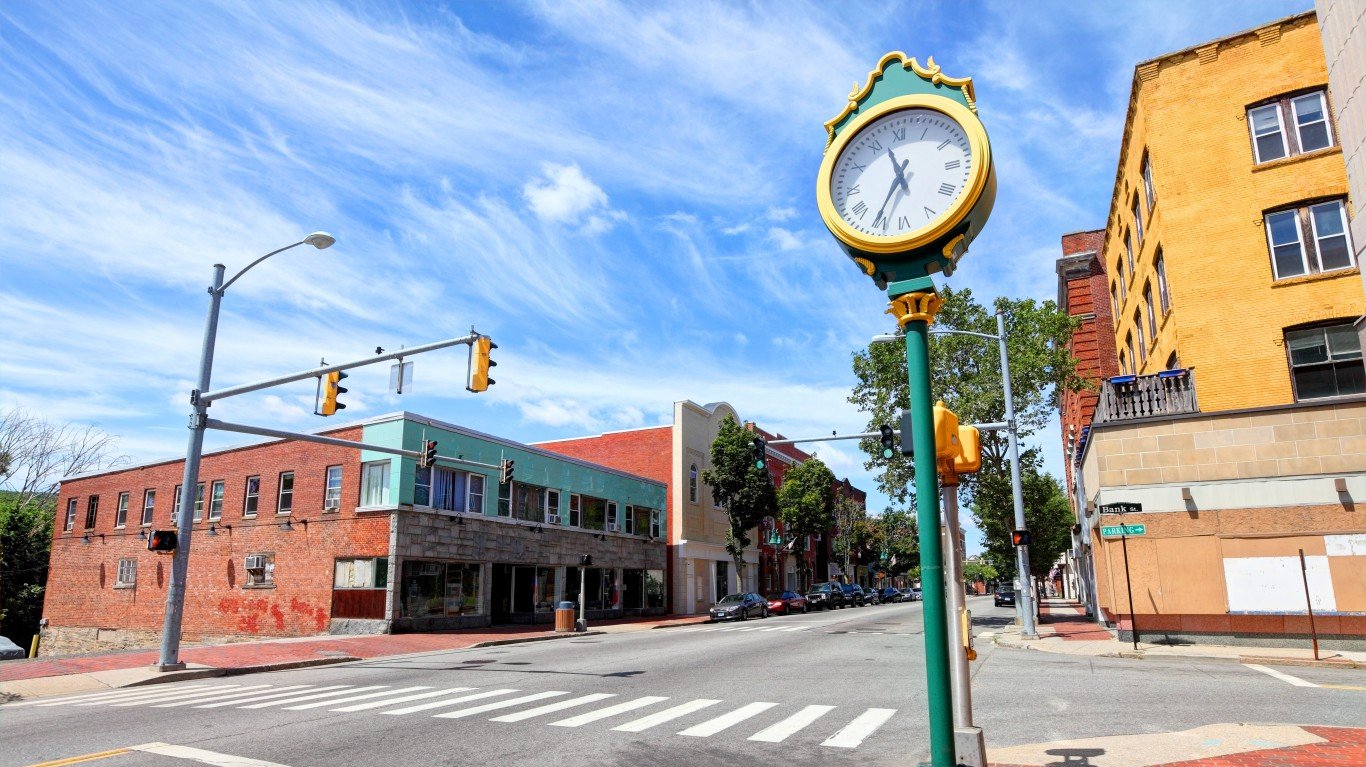
7. Connecticut: Windham County
> Median household income: $66,550 (state: $78,444)
> Poverty rate: 11.4% (state: 9.9%)
> Nov. 2020 unemployment: 7.3% (state: 7.7%)
> Adults with a bachelor’s degree: 24.3% (state: 39.3%)
> Largest place in county: Willimantic
Connecticut is one of the wealthiest states in the country. The typical household in the state earns $78,444 a year, about $15,600 more than the income the typical U.S. household earns annually. Even in Windham County, the poorest county in the state, the median household income of $66,660 is nearly $4,000 higher than the national median income. Similarly, Windham County’s poverty rate of 11.4% is below the U.S. poverty rate of 13.4%, making it one of only four counties that rank as the poorest in their respective state but still have a poverty rate below the national rate.
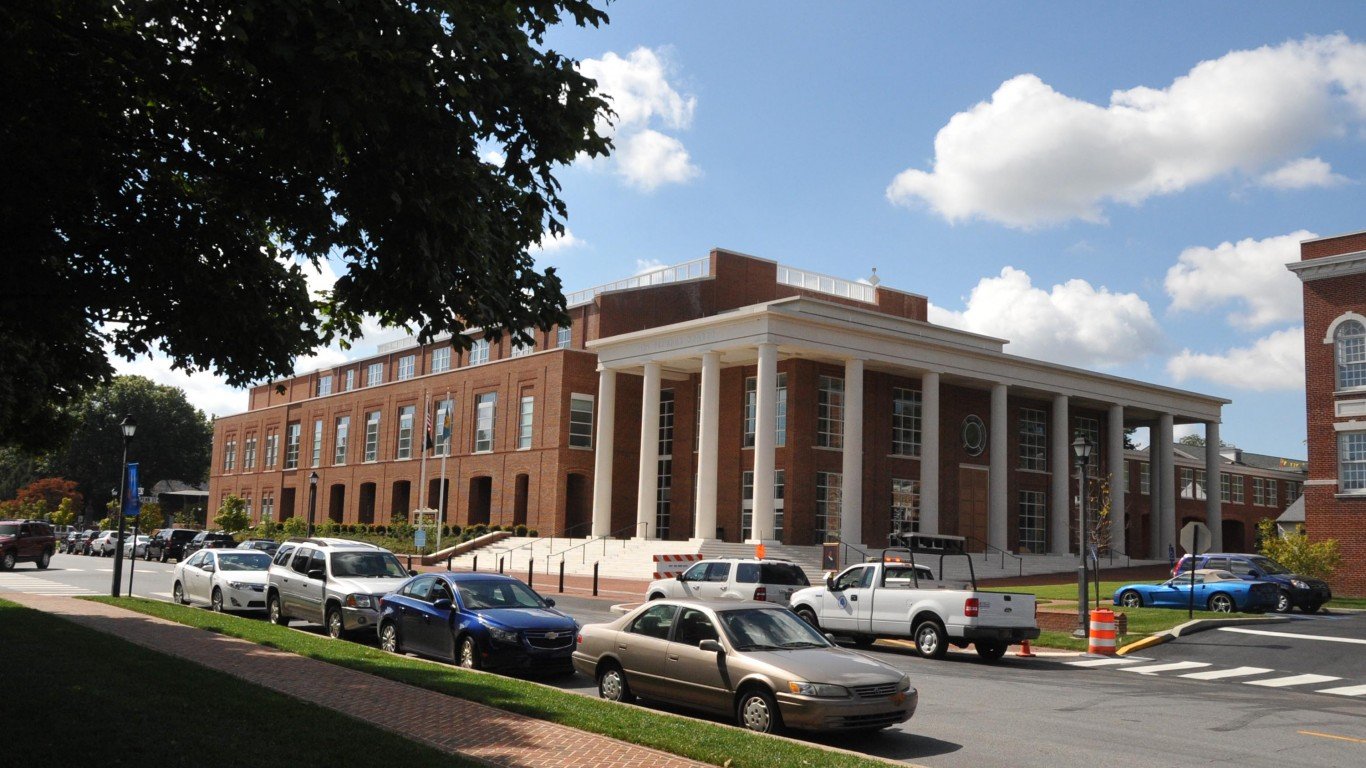
8. Delaware: Kent County
> Median household income: $60,910 (state: $68,287)
> Poverty rate: 13.5% (state: 11.8%)
> Nov. 2020 unemployment: 5.0% (state: 4.7%)
> Adults with a bachelor’s degree: 23.7% (state: 32.0%)
> Largest place in county: Dover
Delaware is a geographically small state comprising only three counties. Partially as a result, the median household income in the poorest county in the state is not much lower than the median income across the state as a whole. In Kent County, which makes up the middle portion of Delaware, the typical household earns $60,910 annually, less than in the state’s two other counties, but only about $7,400 less than the median income across all of Delaware.
The poverty rate in Kent County is also only slightly higher than the state average. An estimated 13.5% of Kent County residents live below the federal poverty threshold, compared to 11.8% of Delaware residents.
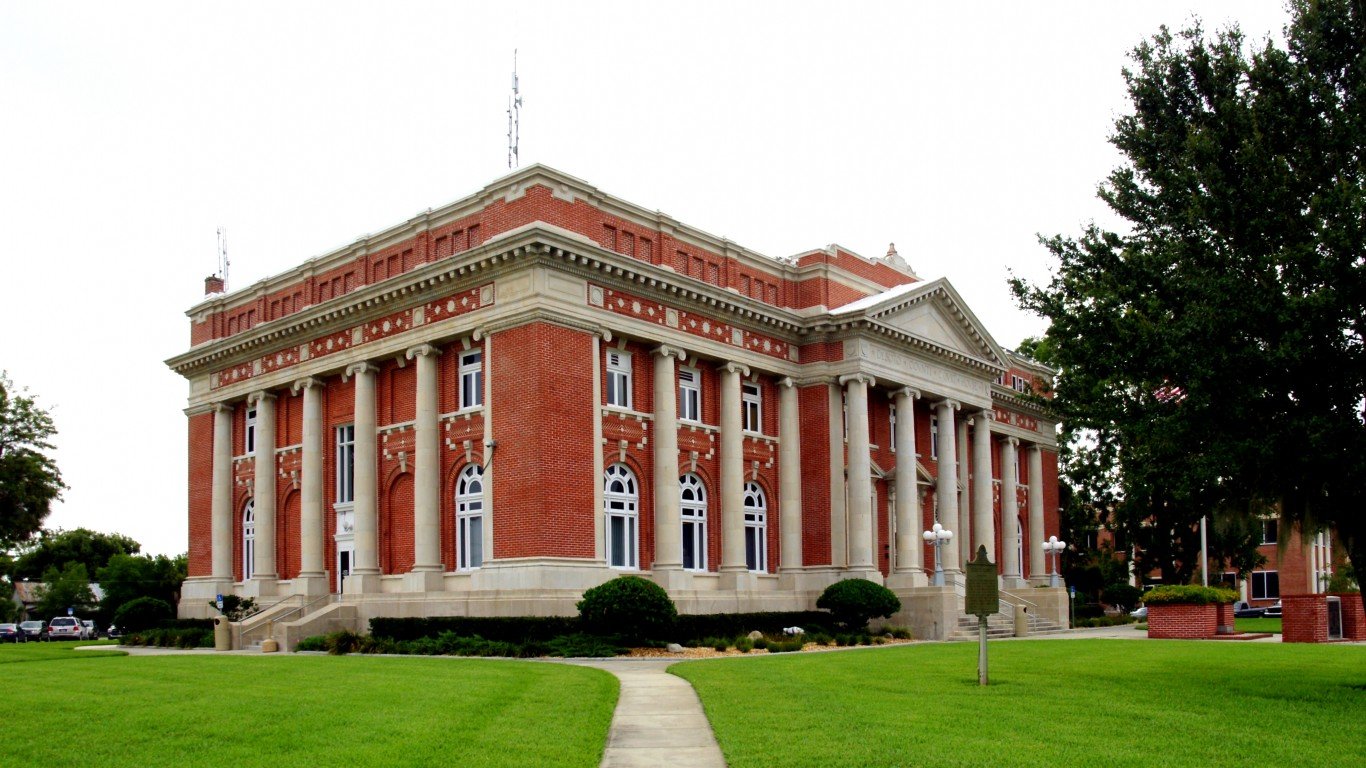
9. Florida: DeSoto County
> Median household income: $35,438 (state: $55,660)
> Poverty rate: 26.8% (state: 14.0%)
> Nov. 2020 unemployment: 4.4% (state: 6.3%)
> Adults with a bachelor’s degree: 11.5% (state: 29.9%)
> Largest place in county: Arcadia
DeSoto, a landlocked county in south central Florida, ranks as the poorest county in the state. The median annual household income in DeSoto County is $35,438, about $20,000 below the statewide median of $55,660.
A high school education is a prerequisite for most jobs, regardless of salary, and in DeSoto County, more than 25% of 25 and older residents have not completed high school. Across Florida, about 12% of adults have not completed high school.
[in-text-ad-2]

10. Georgia: Jenkins County
> Median household income: $27,375 (state: $58,700)
> Poverty rate: 30.5% (state: 15.1%)
> Nov. 2020 unemployment: 5.4% (state: 5.4%)
> Adults with a bachelor’s degree: 7.9% (state: 31.3%)
> Largest place in county: Millen
Jenkins County, located in eastern Georgia about 55 miles south of Augusta, has a median annual household income of just $27,375, which makes it the poorest county in the state and one of only 20 counties or county equivalents nationwide where most households earn less than $30,000 a year.
Americans with higher levels of education tend to be better qualified for higher paying jobs, and as result, well-educated populations typically have higher than average incomes. In Jenkins County, only 7.9% of 25 and older residents have a bachelor’s degree or higher, about a quarter of the statewide bachelor’s degree attainment rate of 31.3%.

11. Hawaii: Hawaii County
> Median household income: $62,409 (state: $81,275)
> Poverty rate: 15.6% (state: 9.4%)
> Nov. 2020 unemployment: 9.8% (state: 10.1%)
> Adults with a bachelor’s degree: 29.4% (state: 33.0%)
> Largest place in county: Hilo
With a median annual household income of $81,275 — about $18,400 more than the national median — Hawaii is one of the wealthiest states in the country. Even in Hawaii County, which ranks as the poorest in the state, the typical household earns $62,409 a year, which is closely in line with the median household income nationwide.
Still, residents of Hawaii County, which is coterminous with the island of Hawaii, are more likely to live in poverty than most Americans. The poverty rate on the island stands at 15.6%, above both the state and national poverty rates of 9.4% and 13.4%, respectively.
[in-text-ad]
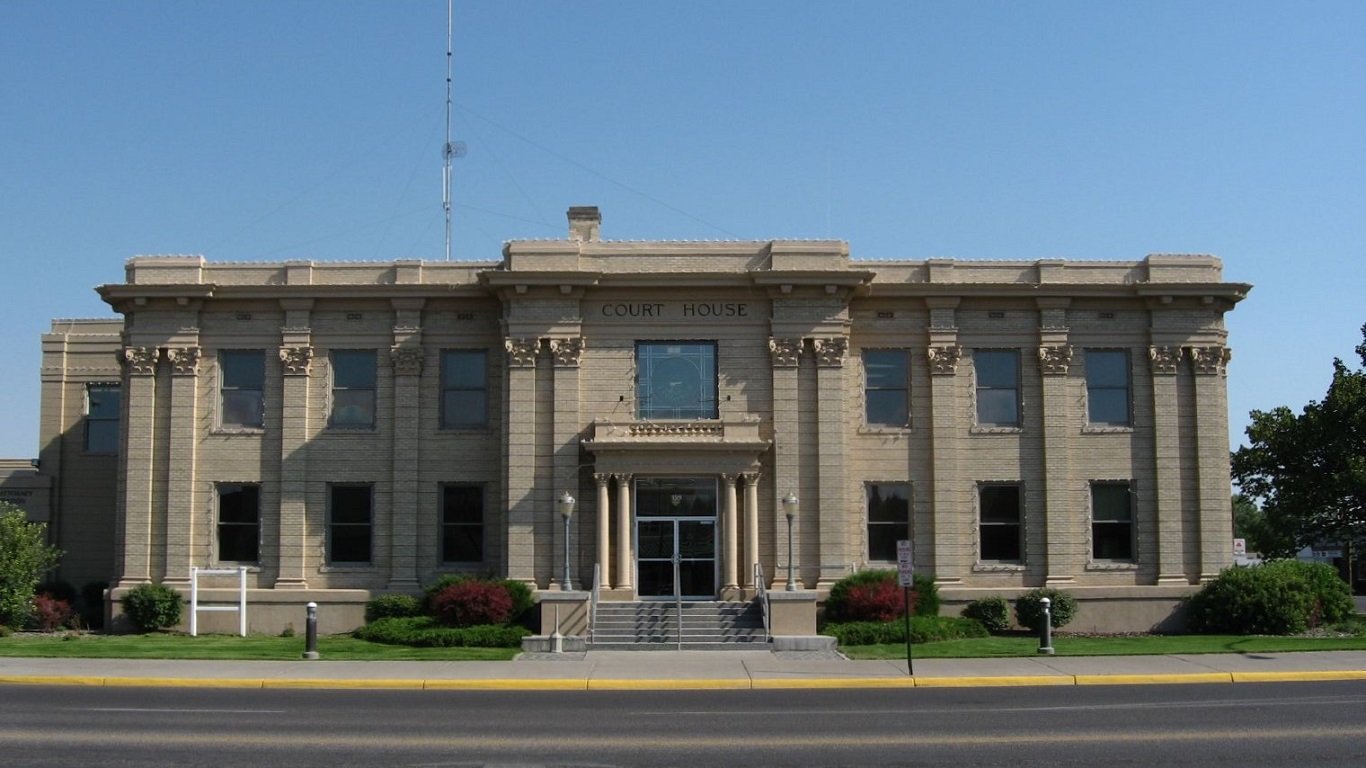
12. Idaho: Madison County
> Median household income: $39,160 (state: $55,785)
> Poverty rate: 30.9% (state: 13.1%)
> Nov. 2020 unemployment: 2.5% (state: 4.8%)
> Adults with a bachelor’s degree: 36.4% (state: 27.6%)
> Largest place in county: Rexburg
Madison County, Idaho, located in the southeastern part of the state not far from the Wyoming border, has a median annual household income of just $39,160, well below the median income across Idaho of $55,785. Madison County’s poverty rate of 30.9% is also more than double the 13.1% poverty rate across all of Idaho.
Unlike most counties that rank as the poorest in their state, Madison County is relatively well educated and has a strong job market. An estimated 36.4% of county adults have a bachelor’s degree or higher, and unemployment in the area stands at just 2.5%. Across Idaho, 27.6% of adults have a four-year degree and the jobless rate is 4.8%.
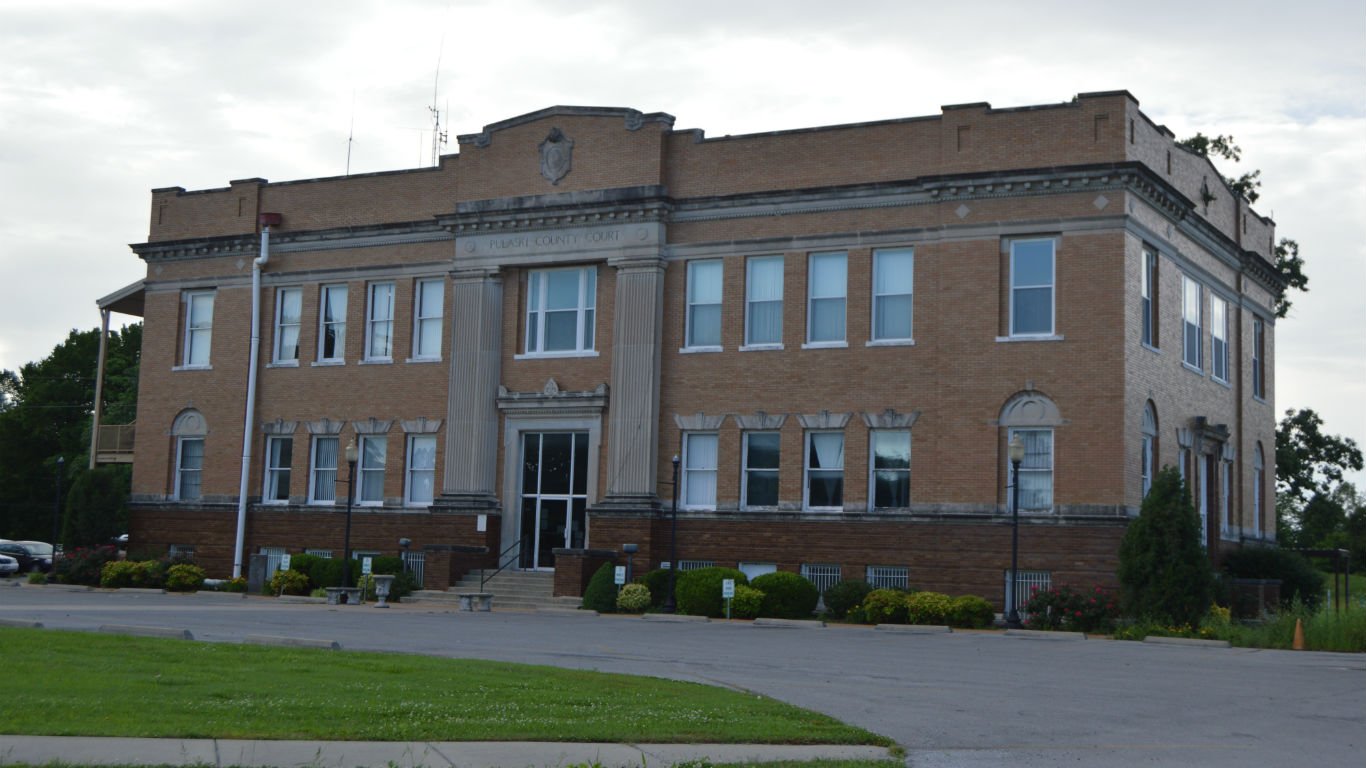
13. Illinois: Pulaski County
> Median household income: $34,640 (state: $65,886)
> Poverty rate: 20.5% (state: 12.5%)
> Nov. 2020 unemployment: 7.9% (state: 6.5%)
> Adults with a bachelor’s degree: 12.5% (state: 34.7%)
> Largest place in county: Mounds
Pulaski County, Illinois — located along the state’s southern border with Kentucky — is the only county in Illinois where most households earn less than $35,000 a year. The county’s median annual household income of $34,640 is over $31,000 shy of the statewide median income of $65,886.
The area’s low incomes are likely due in part to a weak job market. As of November 2020, the unemployment rate in Pulaski County stood at 7.9%, well above both the 6.5% state unemployment rate and 6.4% national rate.
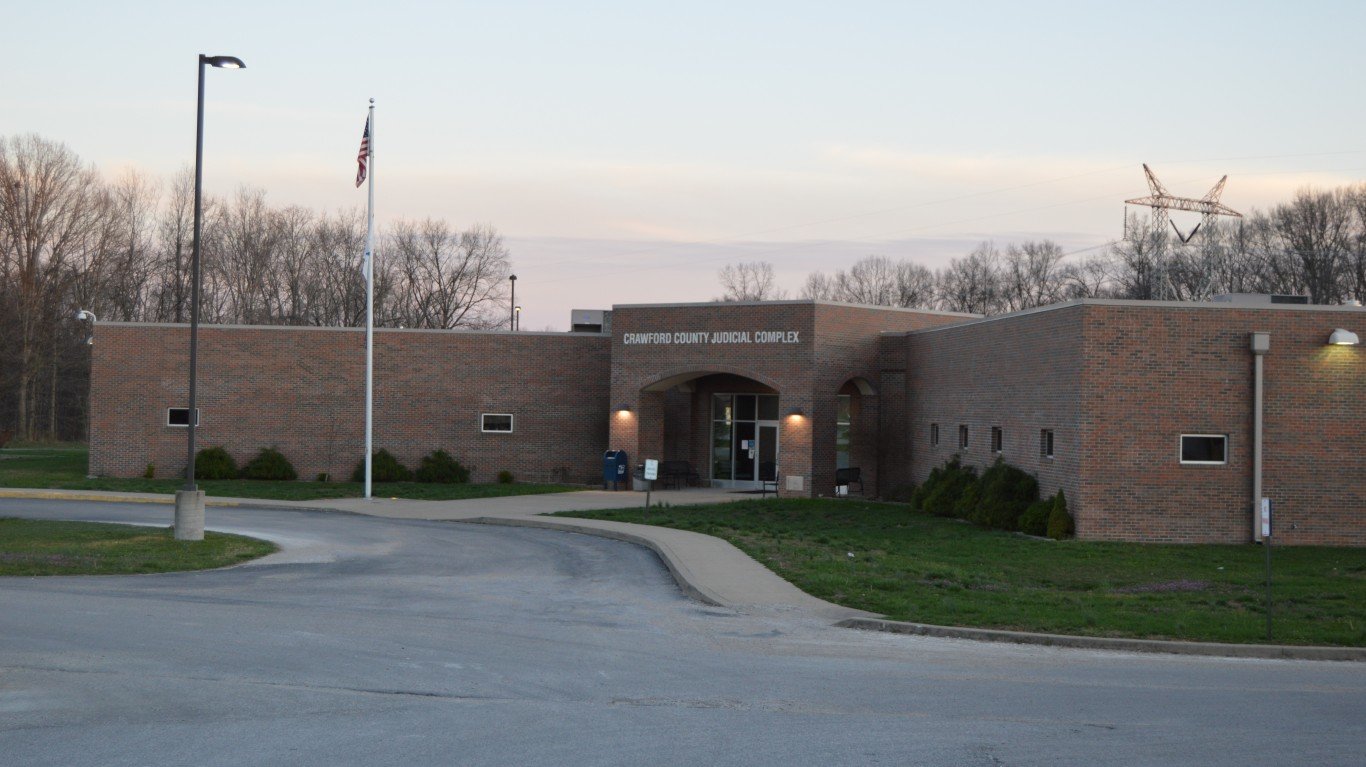
14. Indiana: Crawford County
> Median household income: $41,662 (state: $56,303)
> Poverty rate: 17.9% (state: 13.4%)
> Nov. 2020 unemployment: 5.2% (state: 4.9%)
> Adults with a bachelor’s degree: 10.3% (state: 26.5%)
> Largest place in county: Marengo
Crawford County’s median annual household income of just $41,662 is lower than the median in every other county in Indiana. Of those households in the county that earn less than $41,662 a year, about one in every five earns $10,000 or less annually.
As is often the case in low-income areas, a relatively small share of Crawford County residents have a college education. Just 10.3% of the county’s 25 and older residents have a bachelor’s degree, compared to 26.5% of state residents in the same age group.
[in-text-ad-2]
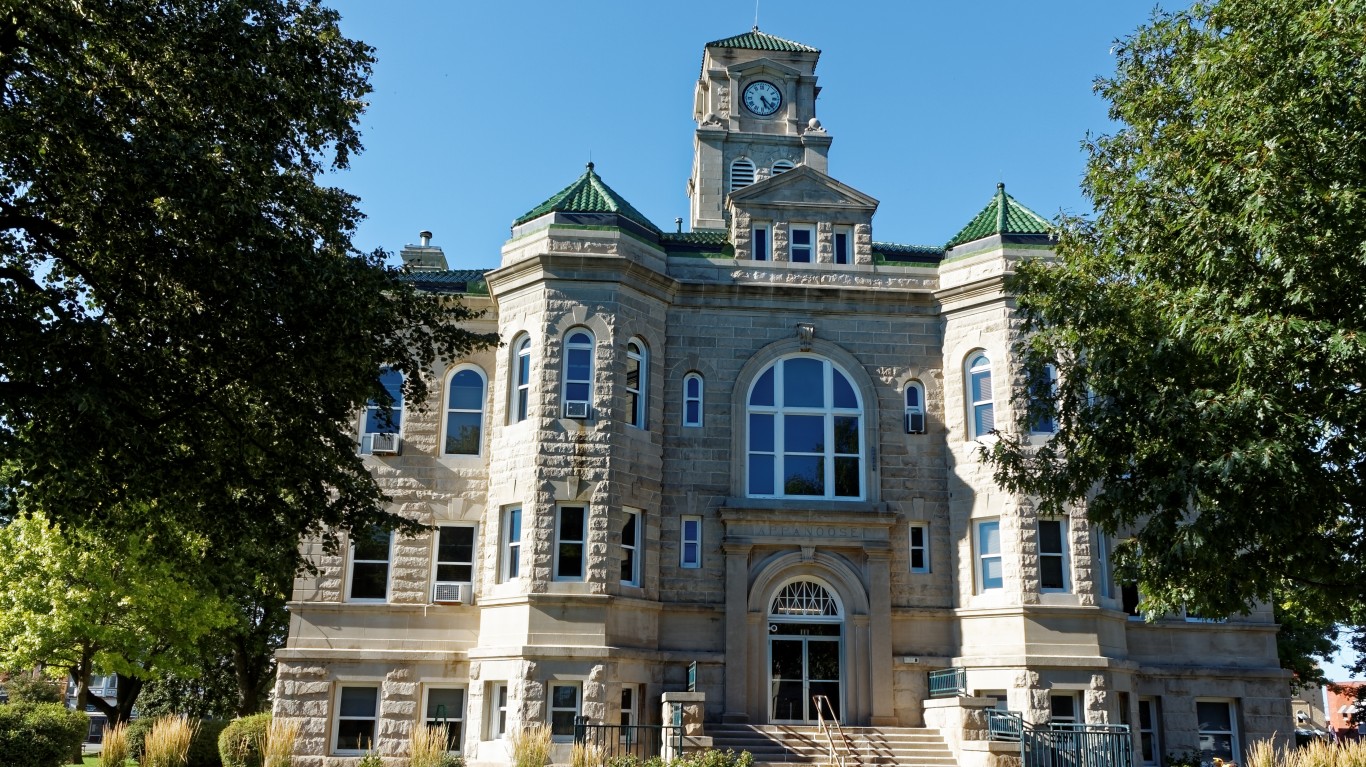
15. Iowa: Appanoose County
> Median household income: $40,167 (state: $60,523)
> Poverty rate: 17.7% (state: 11.5%)
> Nov. 2020 unemployment: 3.4% (state: 3.1%)
> Adults with a bachelor’s degree: 16.3% (state: 28.6%)
> Largest place in county: Centerville
Appanoose County, located in southern Iowa along the Missouri border, has a median annual household income of just $40,167, over $20,000 below the statewide median of $60,523, and the lowest of any county in the state.
Poverty is also far more common in Appanoose County than it is across Iowa. An estimated 11.5% of Iowans live below the poverty line, a smaller share than the 13.4% national poverty rate. In Appanoose County, 17.7% of the population lives on poverty-level wages.

16. Kansas: Chautauqua County
> Median household income: $40,298 (state: $59,597)
> Poverty rate: 18.5% (state: 12.0%)
> Nov. 2020 unemployment: 5.5% (state: 5.3%)
> Adults with a bachelor’s degree: 15.9% (state: 33.4%)
> Largest place in county: Sedan
Chautauqua County, Kansas, is the poorest county in the state by a slim margin. The typical county household earns $40,298 a year, about $400 less than the median income in Jewell County, the state’s second poorest. Incomes in Chautauqua County are far lower than they are across Kansas as a whole, where the typical household earns $59,597 a year.
Incomes tend to rise with educational attainment, and in Kansas’ poorest county, only 15.9% of 25 and older residents have a bachelor’s degree, compared to 33.4% of adults in the state.
[in-text-ad]

17. Kentucky: Bell County
> Median household income: $26,272 (state: $50,589)
> Poverty rate: 35.5% (state: 17.3%)
> Nov. 2020 unemployment: 6.2% (state: 5.1%)
> Adults with a bachelor’s degree: 9.2% (state: 24.2%)
> Largest place in county: Middlesborough
Bell County is not only the poorest county in Kentucky, but also one of the poorest in the United States. The typical county household earns just $26,272 a year, well below the $50,589 median income in Kentucky.
Not only does Bell County have one of the lowest median incomes in the country, but also one of the highest poverty rates. An estimated 35.5% of county residents live below the federal poverty threshold, more than double the 13.5% poverty rate nationwide and the 17.3% poverty rate across Kentucky.

18. Louisiana: Claiborne Parish
> Median household income: $26,776 (state: $49,469)
> Poverty rate: 33.6% (state: 19.2%)
> Nov. 2020 unemployment: 6.3% (state: 8.1%)
> Adults with a bachelor’s degree: 12.8% (state: 24.1%)
> Largest place in county: Homer
Louisiana is one of the poorest states in the country. The typical household in the state earns just $49,469 a year, or about $13,400 less than the income the typical American household earns. As the poorest parish in Louisiana, Claiborne Parish, located in the northern part of the state along the Arkansas border, is also one of the poorest county equivalents in the country. The typical parish household earns just $26,776 a year, less than all but four other U.S. counties with adequate data.
About one in every three residents of Claiborne Parish live below the poverty line, compared to about one in every five Louisiana residents, and 13.4% of all Americans.

19. Maine: Piscataquis County
> Median household income: $40,890 (state: $57,918)
> Poverty rate: 18.5% (state: 11.8%)
> Nov. 2020 unemployment: 4.8% (state: 4.7%)
> Adults with a bachelor’s degree: 18.4% (state: 31.8%)
> Largest place in county: Dover-Foxcroft
In Maine, the typical household earns $57,918 a year, about $5,000 less than the typical American household. In Piscataquis County, a landlocked county in central Maine, the median annual household income of $40,890 is the lowest of any county in the state.
Lower-income areas often have relatively weak job markets, but in Maine’s poorest county, the 4.8% unemployment rate is closely in line with the comparable 4.7% statewide jobless rate and well below the 6.4% national rate.
[in-text-ad-2]

20. Maryland: Allegany County
> Median household income: $45,893 (state: $84,805)
> Poverty rate: 16.5% (state: 9.2%)
> Nov. 2020 unemployment: 6.6% (state: 6.6%)
> Adults with a bachelor’s degree: 18.9% (state: 40.2%)
> Largest place in county: Cumberland
Maryland is the wealthiest state in the country. The typical household in the state earns $84,805 a year, about $22,000 more than the national median household income. Not all parts of the state are equally affluent, however. In Allegany County, located in western Maryland between the Pennsylvania and West Virginia state borders, the median annual household income is just $45,893, about $17,000 less than the income the typical American household earns.
The stark difference between Allegany County and much of the rest of Maryland is further underscored by the share of wealthy households. Only 2.0% of households in Maryland’s poorest county earn $200,000 or more a year, compared to 12.7% of Maryland households who do.
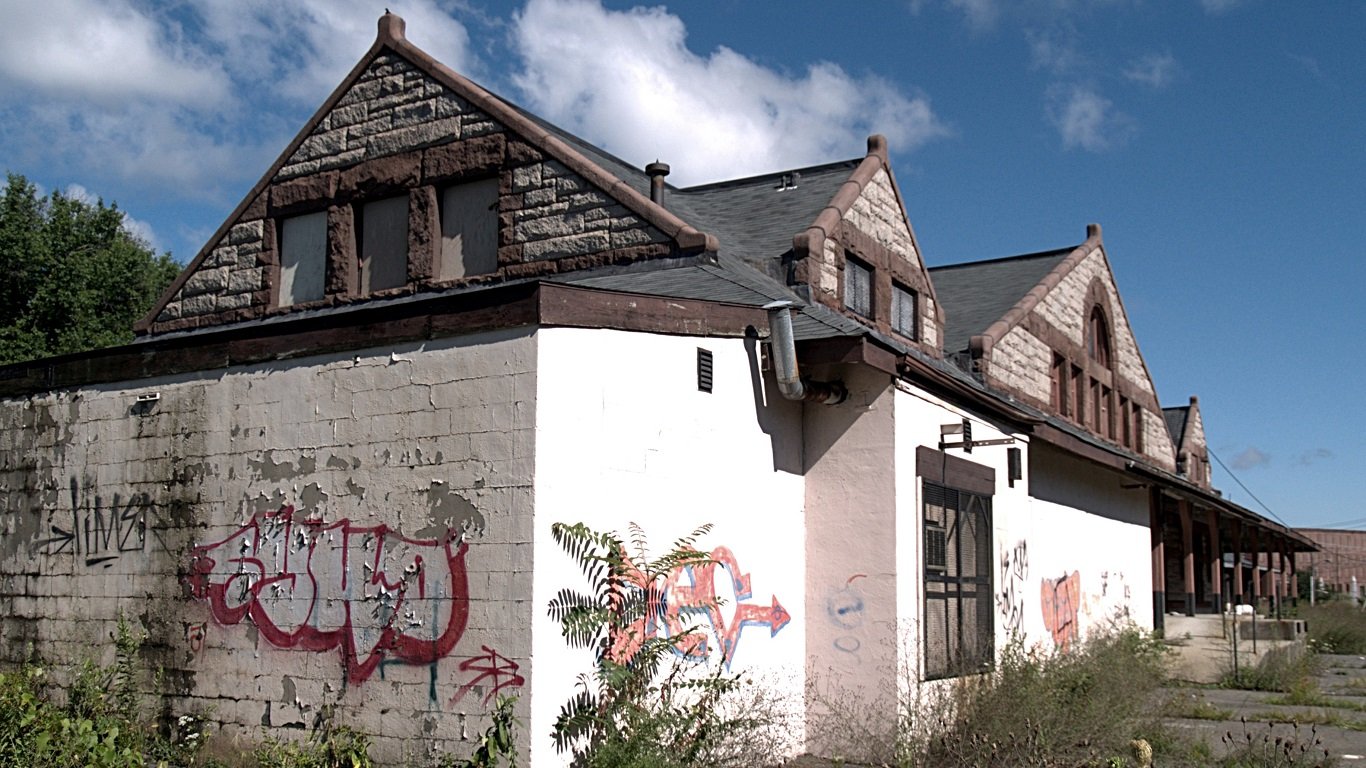
21. Massachusetts: Hampden County
> Median household income: $55,429 (state: $81,215)
> Poverty rate: 16.4% (state: 10.3%)
> Nov. 2020 unemployment: 7.5% (state: 6.2%)
> Adults with a bachelor’s degree: 27.1% (state: 43.7%)
> Largest place in county: Springfield
With a median annual household income of $81,215, Massachusetts is one of the wealthiest states in the country. Hampden County, which ranks as the poorest county in the state, has a median household income of just $55,429, which is about $7,400 below the national median.
Higher-paying jobs typically require a well-educated workforce, and many jobs in Hampden County do not require a college degree. Only 27.1% of the 25 and older residents in the county have a bachelor’s degree, compared to 43.7% of adults in Massachusetts.
[in-text-ad]

22. Michigan: Lake County
> Median household income: $37,320 (state: $57,144)
> Poverty rate: 21.0% (state: 14.4%)
> Nov. 2020 unemployment: 6.6% (state: 6.3%)
> Adults with a bachelor’s degree: 11.9% (state: 29.1%)
> Largest place in county: Baldwin
Lake County, a landlocked area in west central Michigan, is the poorest county in the state and the only county in Michigan where most households earn less than $38,000 a year. Lake County’s median household income of $37,320 is about $20,000 below the $57,144 statewide median.
Incomes in Lake County would likely increase with greater job availability. Unemployment in the area stands at 6.6%, slightly higher than the statewide jobless rate of 6.3%.

23. Minnesota: Mahnomen County
> Median household income: $44,688 (state: $71,306)
> Poverty rate: 23.3% (state: 9.7%)
> Nov. 2020 unemployment: 6.6% (state: 3.9%)
> Adults with a bachelor’s degree: 13.2% (state: 36.1%)
> Largest place in county: Mahnomen
Minnesota is one of only 13 states where most households earn over $70,000 a year. Still, some parts of Minnesota are less affluent. In Mahnomen County, which covers parts of the White Earth Indian Reservation, the median annual household income is $44,688, about $18,000 less than the national median household income.
Indian reservations in the United States are often economically disadvantaged due to a range of factors — both historical and contemporary. In Mahnomen County, 23.3% of the population lives below the poverty line, more than double the 9.7% poverty rate across all of Minnesota.
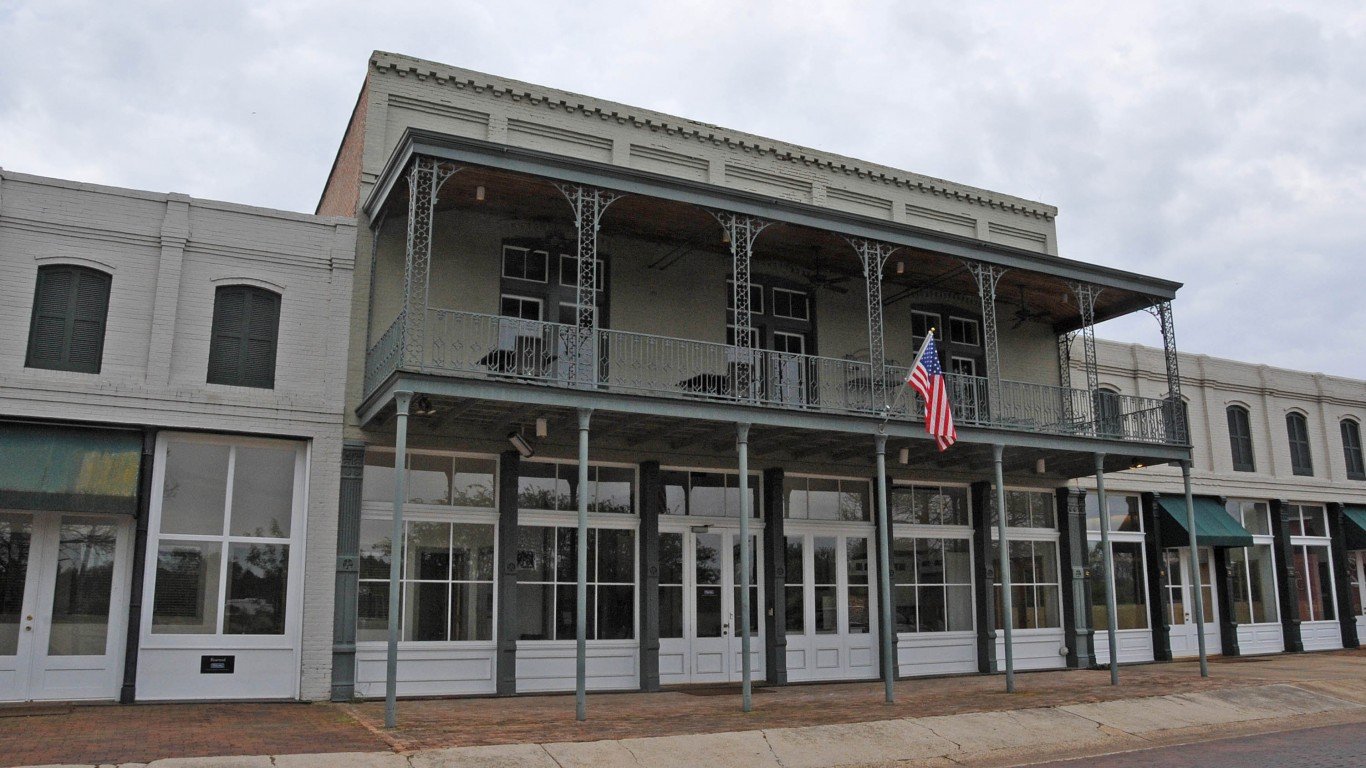
24. Mississippi: Leflore County
> Median household income: $26,735 (state: $45,081)
> Poverty rate: 36.8% (state: 20.3%)
> Nov. 2020 unemployment: 9.2% (state: 6.0%)
> Adults with a bachelor’s degree: 18.5% (state: 22.0%)
> Largest place in county: Greenwood
With a median annual household income of just $45,081, Mississippi is the poorest state in the country. In Leflore County, the poorest in Mississippi, the median annual household income is $26,735, far less than half of the income the typical American household earns.
As is the case in many low-income counties around the country, Leflore has high poverty and high unemployment. An estimated 36.8% of the local population lives below the poverty line, more than double the 13.4% national poverty rate. Also, 9.2% of the labor force is unemployed, compared to the 6.4% U.S. jobless rate.
[in-text-ad-2]

25. Missouri: Ozark County
> Median household income: $31,947 (state: $55,461)
> Poverty rate: 29.6% (state: 13.7%)
> Nov. 2020 unemployment: 4.7% (state: 3.9%)
> Adults with a bachelor’s degree: 11.0% (state: 29.2%)
> Largest place in county: Gainesville
Ozark County’s median household income of just $31,947 is well below the statewide median of $55,461, and about half the median household income nationwide. While Missouri’s poverty rate of 13.7% is in line with the 13.4% U.S. poverty rate, in Ozark, Missouri’s poorest county, nearly 30% of the population lives below the poverty line.
Ozark County also has a high share of households facing serious financial hardship. An estimated 12.2% of households in the county live on less than $10,000 a year, nearly double the 6.2% comparable share across the state as a whole.
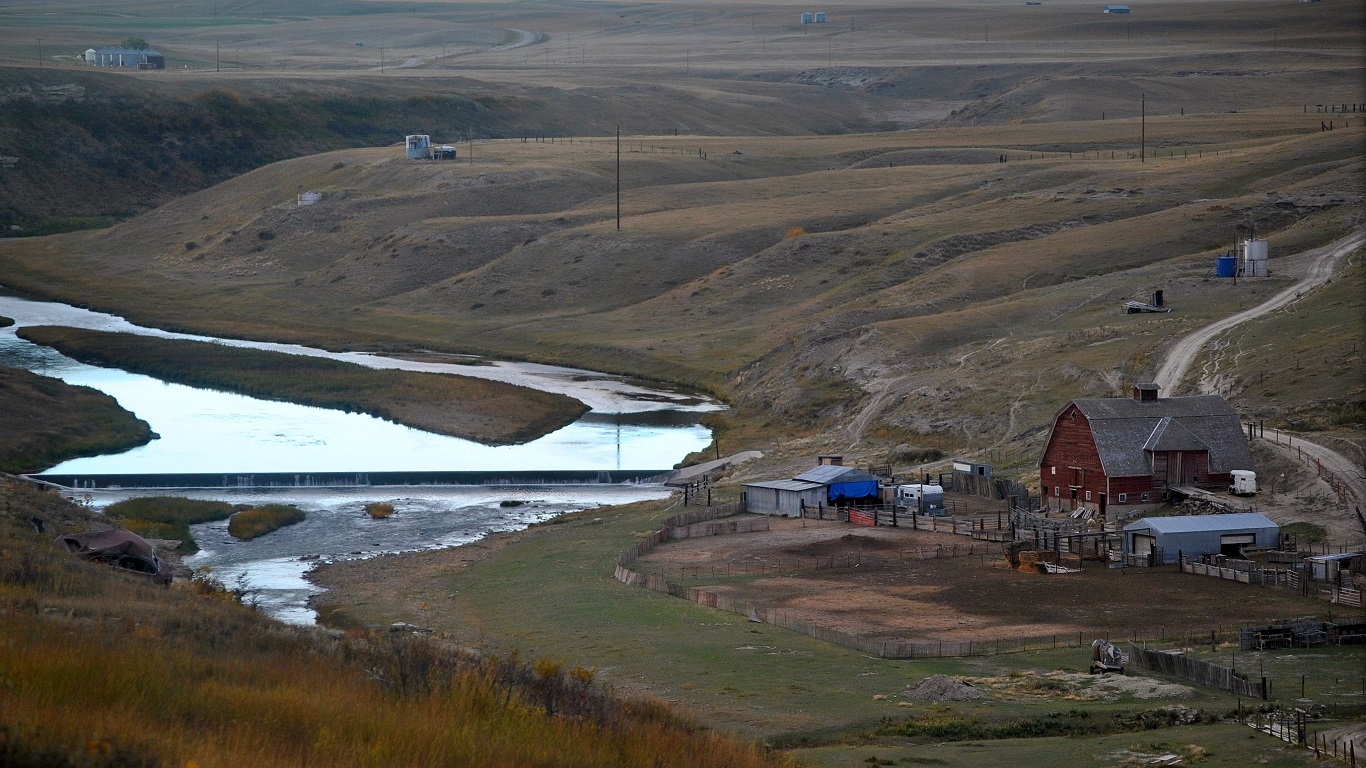
26. Montana: Glacier County
> Median household income: $36,045 (state: $54,970)
> Poverty rate: 31.0% (state: 13.1%)
> Nov. 2020 unemployment: 8.0% (state: 4.3%)
> Adults with a bachelor’s degree: 21.4% (state: 32.0%)
> Largest place in county: Cut Bank
Glacier County, located along the Canadian border and covering much of the Blackfeet Indian Reservation, is the poorest county in Montana. With a median annual household income of $36,045, Glacier is the only county in Montana where most households earn less than $40,000 a year.
Due to a number of historical and contemporary factors, Native American Reservations are often economically disadvantaged. In Glacier County, unemployment stands at 8.0% and 31.0% of the population lives below the poverty line. Across all of Montana, the unemployment rate is 4.3% and 13.1% of the population lives on poverty level income.
[in-text-ad]

27. Nebraska: Dundy County
> Median household income: $41,716 (state: $61,439)
> Poverty rate: 10.6% (state: 11.1%)
> Nov. 2020 unemployment: 2.2% (state: 2.7%)
> Adults with a bachelor’s degree: 23.3% (state: 31.9%)
> Largest place in county: Benkelman
Dundy County, which is in the southwestern corner of Nebraska on its border with Colorado and Kansas, is the poorest in the state. Dundy, one of the smallest counties in the country with a population of just 1,913 as of 2019, has a median annual household income of $41,716, roughly $20,000 less than the median household income statewide.
Americans with lower educational attainment are less likely to earn higher incomes, and in Dundy County, just 83.1% of adults have a high school diploma, about 5 percentage points lower than the national share and one of the lowest adult high school attainment rates in the state.

28. Nevada: Nye County
> Median household income: $47,300 (state: $60,365)
> Poverty rate: 16.4% (state: 13.1%)
> Nov. 2020 unemployment: 7.6% (state: 9.9%)
> Adults with a bachelor’s degree: 10.7% (state: 24.7%)
> Largest place in county: Pahrump
Nye County extends from the central part of Nevada down to the state’s southwestern border with California. With a median annual household income of $47,300, Nye is the only county in Nevada where most households earn less than $50,000 a year.
Unlike many poor U.S. counties, Nye’s job market is stronger than in many other parts of the state. While the 7.6% unemployment rate in the county is higher than the comparabl 6.4% national rate, it is well below the 9.9% statewide jobless rate.

29. New Hampshire: Coos County
> Median household income: $47,117 (state: $76,768)
> Poverty rate: 12.5% (state: 7.6%)
> Nov. 2020 unemployment: 4.4% (state: 3.5%)
> Adults with a bachelor’s degree: 18.2% (state: 37.0%)
> Largest place in county: Berlin
Coos County, which comprises the northernmost section of New Hampshire, is by far the poorest county in the state. The typical county household earns just $47,117 a year, well below the median annual household income of $76,768 across the state and the $61,312 median income in Sullivan County, the second poorest county in the Granite State.
At 7.6%, New Hampshire has the lowest poverty rate of any state. Even though the poverty rate in Coos County of 12.5% is well above the statewide rate, it is still below the national poverty rate of 13.4%.
[in-text-ad-2]
30. New Jersey: Cumberland County
> Median household income: $54,149 (state: $82,545)
> Poverty rate: 16.5% (state: 10.0%)
> Nov. 2020 unemployment: 11.2% (state: 9.9%)
> Adults with a bachelor’s degree: 15.6% (state: 39.7%)
> Largest place in county: Vineland
New Jersey’s Cumberland County is located in the southern part of the state on the Delaware bay, and is farther than most state counties from the Philadelphia or New York metropolitan areas. Living in close proximity to major cities can provide greater economic opportunities and raise regional incomes, a fact that can help explain why Cumberland County is the poorest in the state.
The typical household in Cumberland County has an annual income of $54,149 — much lower than the state median of $82,545 but much higher than many of the poorest counties in other parts of the country.

31. New Mexico: Quay County
> Median household income: $29,035 (state: $49,754)
> Poverty rate: 20.4% (state: 19.1%)
> Nov. 2020 unemployment: 7.1% (state: 7.3%)
> Adults with a bachelor’s degree: 17.1% (state: 27.3%)
> Largest place in county: Tucumcari
Quay County is a relatively remote and rural county in eastern New Mexico along the Texas state border. Many of the poorest counties in the United States are rural, and with a median household income of just $29,035, Quay County is one of them. The typical U.S. household earns more than twice as much as the typical household in Quay, and the typical household in New Mexico earns about $13,000 more.
While incomes are far lower in Quay County than in much of the rest of the state, the local poverty rate of 20.4% is closely in line with the state poverty rate of 19.1%. Both Quay County and New Mexico as a whole have far higher poverty rates than the national rate of 13.4%.
[in-text-ad]
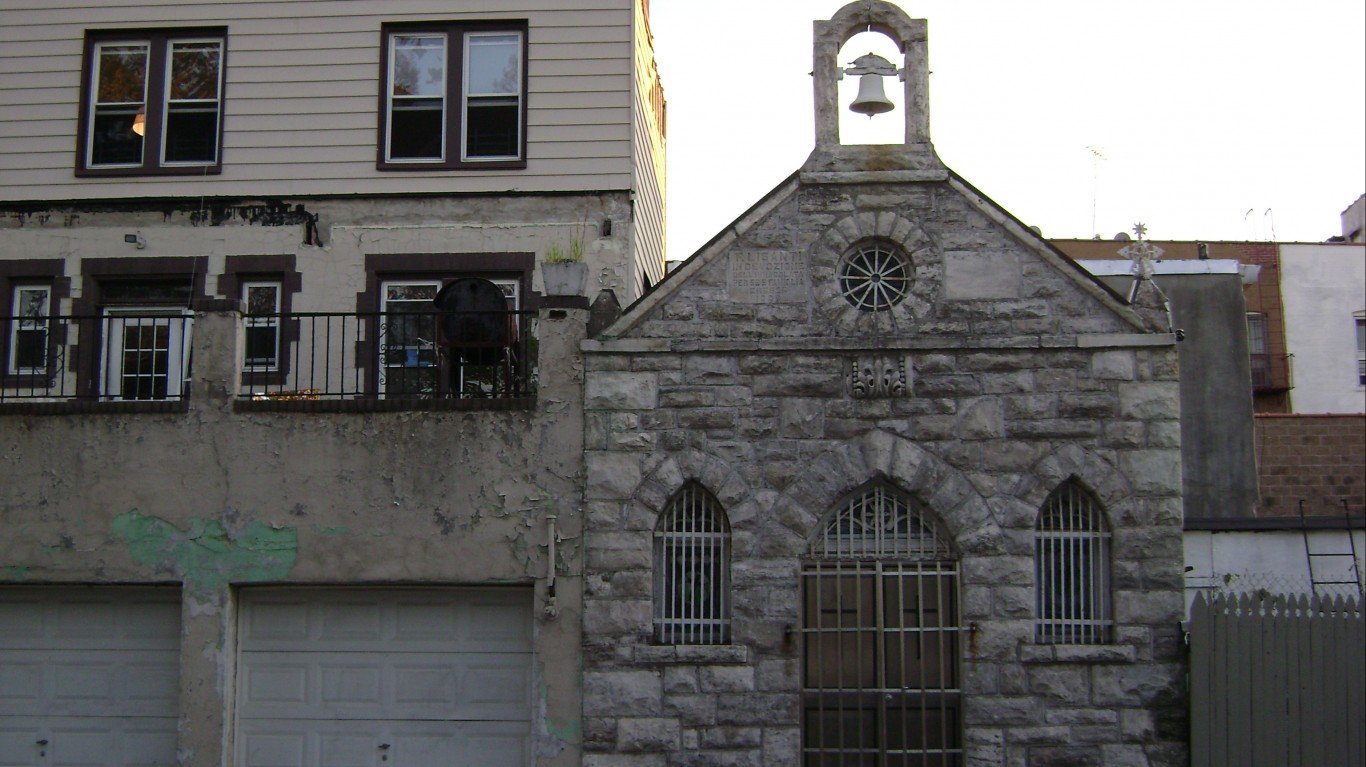
32. New York: Bronx County
> Median household income: $40,088 (state: $68,486)
> Poverty rate: 28.0% (state: 14.1%)
> Nov. 2020 unemployment: 16.0% (state: 8.1%)
> Adults with a bachelor’s degree: 20.1% (state: 36.6%)
> Largest place in county: New York
Most of New York’s wealthiest counties can be found in the New York City metropolitan area, either in the five boroughs, or in the commuter counties on Long Island, or upstate. The city is also home to the state’s poorest county, in the Bronx. In nearby New York County, better known as Manhattan, the typical home has an income of $86,553 annually. In the Bronx, the median household income is less than half of that, at $40,088.
Among Bronx County residents, 28.0% have incomes below the poverty line, and 13.5% of households earn less than $10,000 annually. In Queens, 12.2% of residents live in poverty and 5.6% of households earn less than $10,000.
33. North Carolina: Robeson County
> Median household income: $34,976 (state: $54,602)
> Poverty rate: 27.7% (state: 14.7%)
> Nov. 2020 unemployment: 8.3% (state: 6.1%)
> Adults with a bachelor’s degree: 13.7% (state: 31.3%)
> Largest place in county: Lumberton
Robeson County, located in southeastern North Carolina along the South Carolina border, has a median annual household income of just $34,976, making it the only county in the state where most households earn less than $35,000 annually. Meanwhile, the typical North Carolina household earns $54,602 a year.
Incomes tend to rise with educational attainment, and in Robeson County, just 13.7% of adults have a bachelor’s degree, compared to 31.3% of adults in North Carolina. Additionally, more than 20% of adults in Robeson County have not completed high school, compared to fewer than 15% of adults in North Carolina.
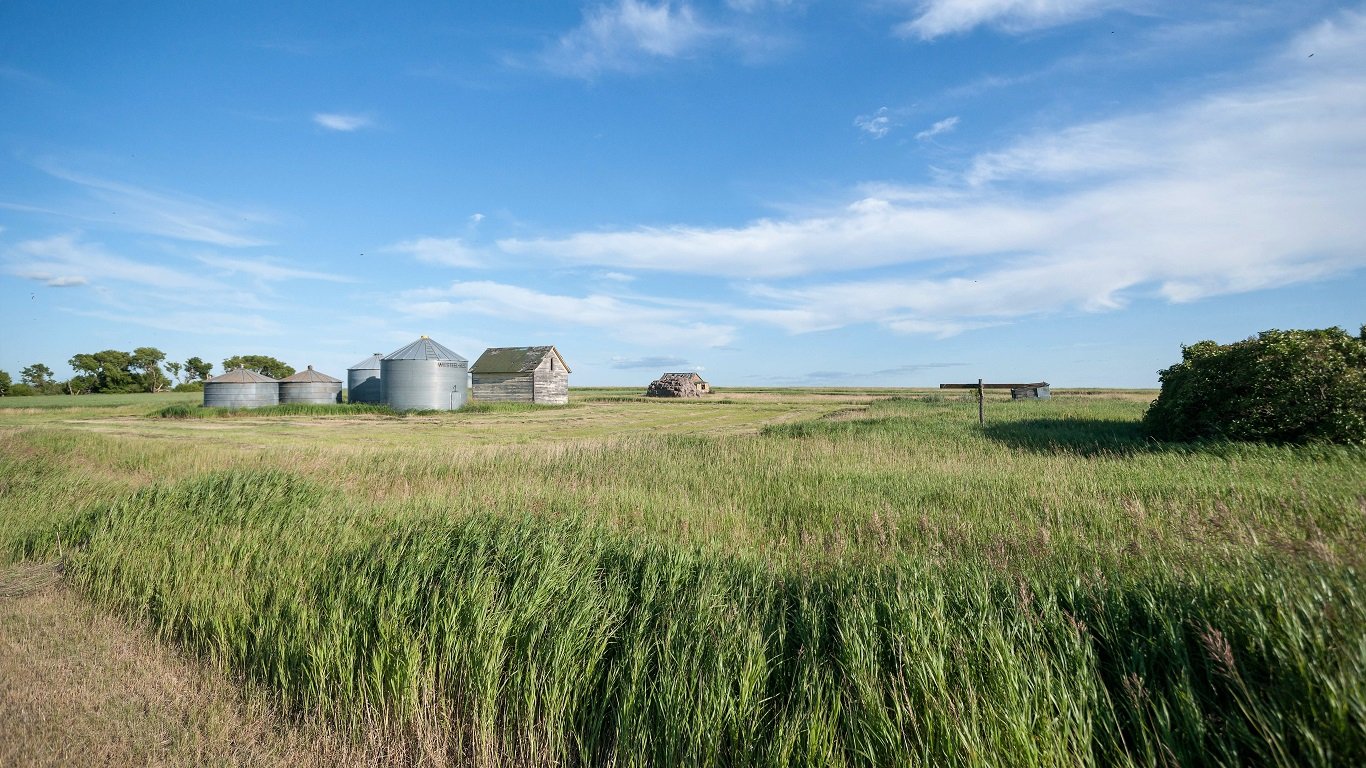
34. North Dakota: Rolette County
> Median household income: $43,158 (state: $64,894)
> Poverty rate: 27.1% (state: 10.7%)
> Nov. 2020 unemployment: 10.5% (state: 4.1%)
> Adults with a bachelor’s degree: 19.6% (state: 30.0%)
> Largest place in county: Belcourt
Rolette County, the poorest in North Dakota, comprises a relatively rural and remote area along the Canadian border. With a median annual household income of $43,158, Rolette is the only county in the state where most households earn less than $45,000 a year.
In Rolette County, residents are more than twice as likely to live below the poverty line than the North Dakota residents. Widespread financial hardship is likely partly the result of a weak job market. Unemployment in the area stands at 10.5% — more than double the 4.1% state jobless rate.
[in-text-ad-2]
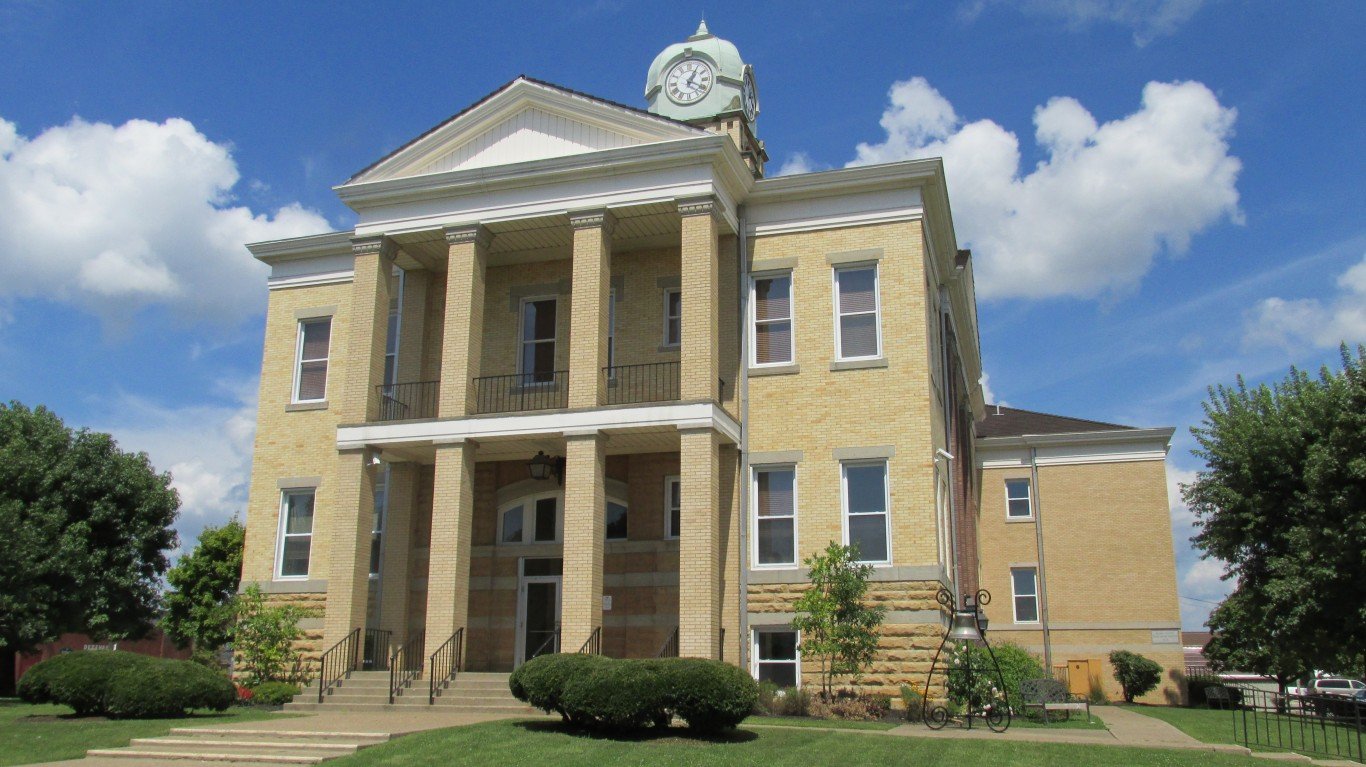
35. Ohio: Adams County
> Median household income: $39,079 (state: $56,602)
> Poverty rate: 20.7% (state: 14.0%)
> Nov. 2020 unemployment: 6.2% (state: 5.2%)
> Adults with a bachelor’s degree: 13.2% (state: 28.3%)
> Largest place in county: West Union
Adams county, located on Ohio’s border with Kentucky, is the poorest in the state, with a median annual household income of $39,079. Over 20% of the county’s roughly 28,000 residents live below the poverty line, and 11.2% of households live on less than $10,000 annually, compared to 14% of state residents living below the poverty line and 6.8% of Ohio households with annual incomes of less than $10,000.
Lower educational attainment typically corresponds with lower incomes, and in Adams County, just 13.2% of adults have a bachelor’s degree, compared to 28.3% of Ohio adults and 32.1% of adults nationwide.
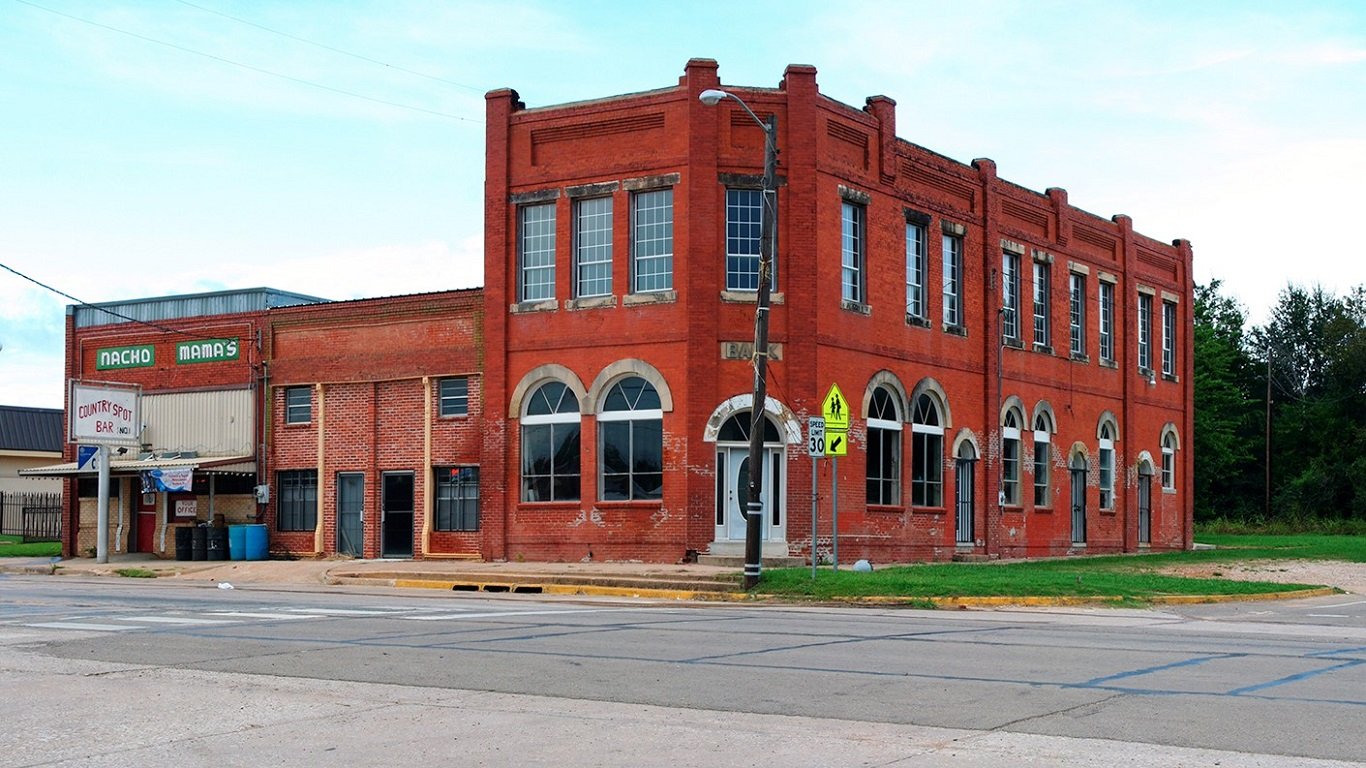
36. Oklahoma: Choctaw County
> Median household income: $34,489 (state: $52,919)
> Poverty rate: 27.7% (state: 15.7%)
> Nov. 2020 unemployment: 8.0% (state: 5.8%)
> Adults with a bachelor’s degree: 13.4% (state: 25.5%)
> Largest place in county: Hugo
Choctaw County, Oklahoma, covers the southern portion of the Choctaw Nation in Oklahoma. For a number of reasons, both historical and contemporary, Native American populations are, on the whole, an economically disadvantaged group. In Choctaw County, the poorest county in Oklahoma, the median annual household income is just $34,489 — well below the statewide median of $52,919.
Low-income areas are often home to large populations living below the federal poverty threshold, and Choctaw is no exception. An estimated 27.7% of county residents live in poverty, compared to 15.7% of Oklahomans and 13.4% of all Americans.
[in-text-ad]
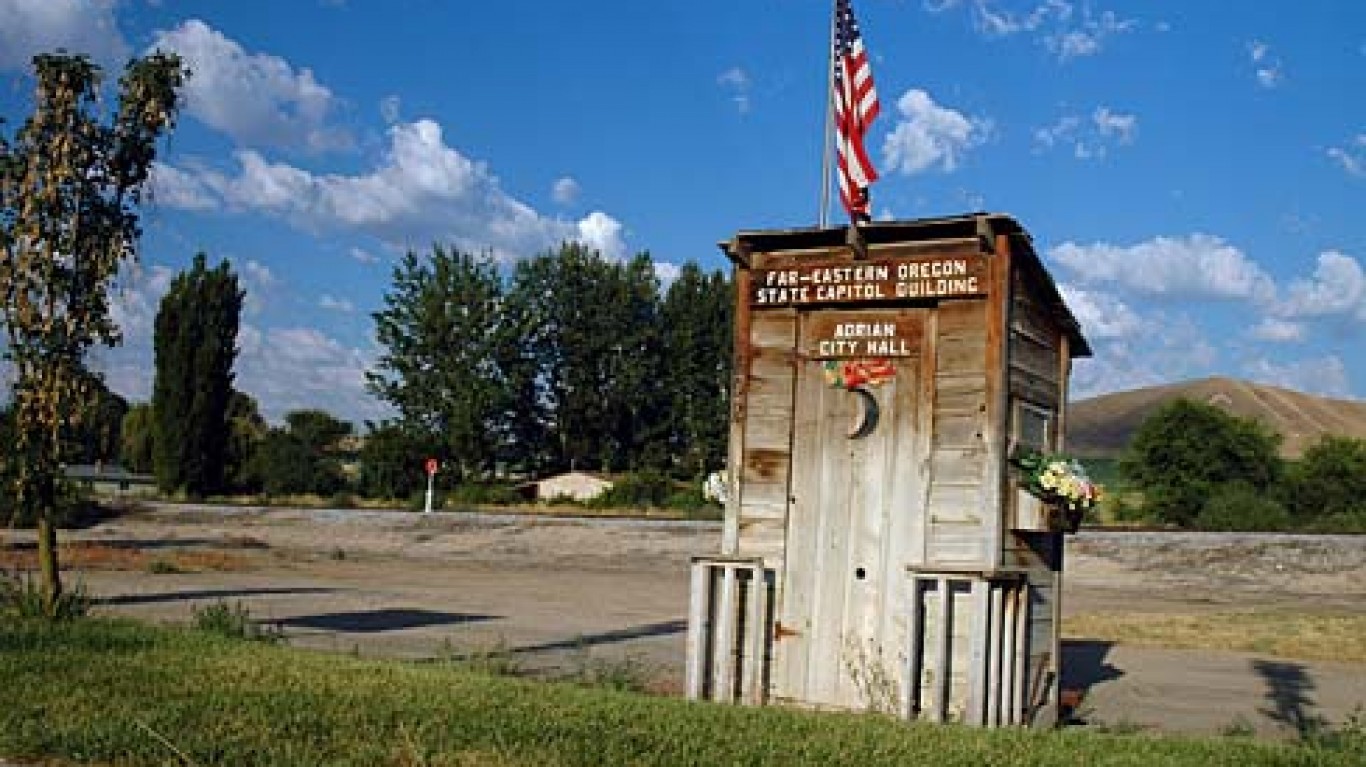
37. Oregon: Malheur County
> Median household income: $43,313 (state: $62,818)
> Poverty rate: 21.8% (state: 13.2%)
> Nov. 2020 unemployment: 3.6% (state: 5.5%)
> Adults with a bachelor’s degree: 13.7% (state: 33.7%)
> Largest place in county: Ontario
Oregon’s Malheur County, the poorest in the state, is located on the state’s southeastern border, with the closest major city being Boise, Idaho. The typical household in Malheur County has an annual income of $43,313, nearly $20,000 below the state median household income of $62,818. Lower educational attainment typically corresponds with lower incomes, and in Malheur County, just 13.7% of adults have a bachelor’s degree, compared to 33.7% of Ohio adults and 32.1% of adults nationwide.
38. Pennsylvania: Forest County
> Median household income: $39,717 (state: $61,744)
> Poverty rate: 18.1% (state: 12.4%)
> Nov. 2020 unemployment: 7.2% (state: 6.1%)
> Adults with a bachelor’s degree: 8.1% (state: 31.4%)
> Largest place in county: Tionesta
Much of Pennsylvania’s Forest County, located in the northwestern part of the state, is in Allegheny National Forest. It is one of the least population-dense counties in the state, and compared to most counties in the state is also relatively far from major population centers such Philadelphia or Pittsburgh. Living in close proximity to major cities can provide greater economic opportunities and raise regional incomes, a fact that can help explain why Forest County is the poorest in the state. The county’s median annual household income of $39,717 is over $20,000 lower than the state median of $61,744.
Workers without a college degree are likely to earn lower wages than workers who have a degree. Just 8.1% of adults in Forest County have a bachelor’s degree, making it the only county in the state where fewer than 10% of 25 and over residents have a four-year college degree. In comparison, 31.4% of state adults have a bachelor’s degree.
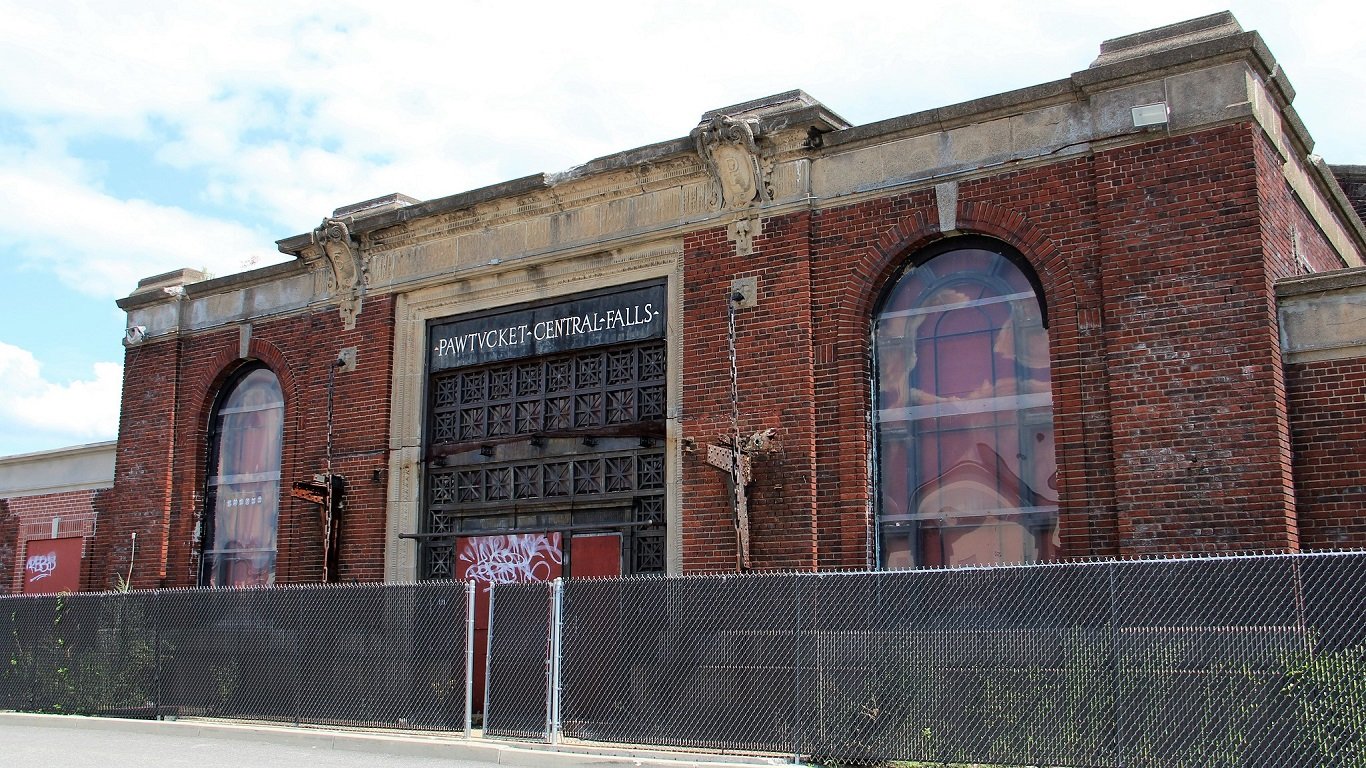
39. Rhode Island: Providence County
> Median household income: $58,974 (state: $67,167)
> Poverty rate: 15.2% (state: 12.4%)
> Nov. 2020 unemployment: 7.6% (state: 7.0%)
> Adults with a bachelor’s degree: 29.0% (state: 34.2%)
> Largest place in county: Providence
Rhode Island is a geographically small state, comprising only five counties. Partially as a result, the median household income in the poorest county in the state is not much lower than the median income across the state as a whole. In Providence County, which includes the city of Providence, the typical household earns $58,974 annually, compared to the statewide median of $67,167.
In Rhode Island’s other four counties, median household incomes range from $73,521 in Kent County to $85,531 in Washington County. Providence is also the only county in the state where the share of adults with a bachelor’s degree is below the 32.1% national share.
[in-text-ad-2]
40. South Carolina: Dillon County
> Median household income: $30,812 (state: $53,199)
> Poverty rate: 32.6% (state: 15.2%)
> Nov. 2020 unemployment: 4.7% (state: 4.1%)
> Adults with a bachelor’s degree: 11.1% (state: 28.1%)
> Largest place in county: Dillon
Dillon County, South Carolina, in the state’s northeastern corner, borders North Carolina and near the city of Florence. The typical household in Dillon County has an annual income of $30,812, compared to a state median household income of $53,199. Almost one in three county residents earn incomes below the poverty line, the largest share of any South Carolina county and more than double the state or national poverty rates.
An estimated 16.4% of Dillon County households live on less than $10,000 per year compared to 7.4% of state households. The county’s share of households earning extremely low incomes is the second highest of any South Carolina county, behind Marion County, and one of the highest shares in the country.
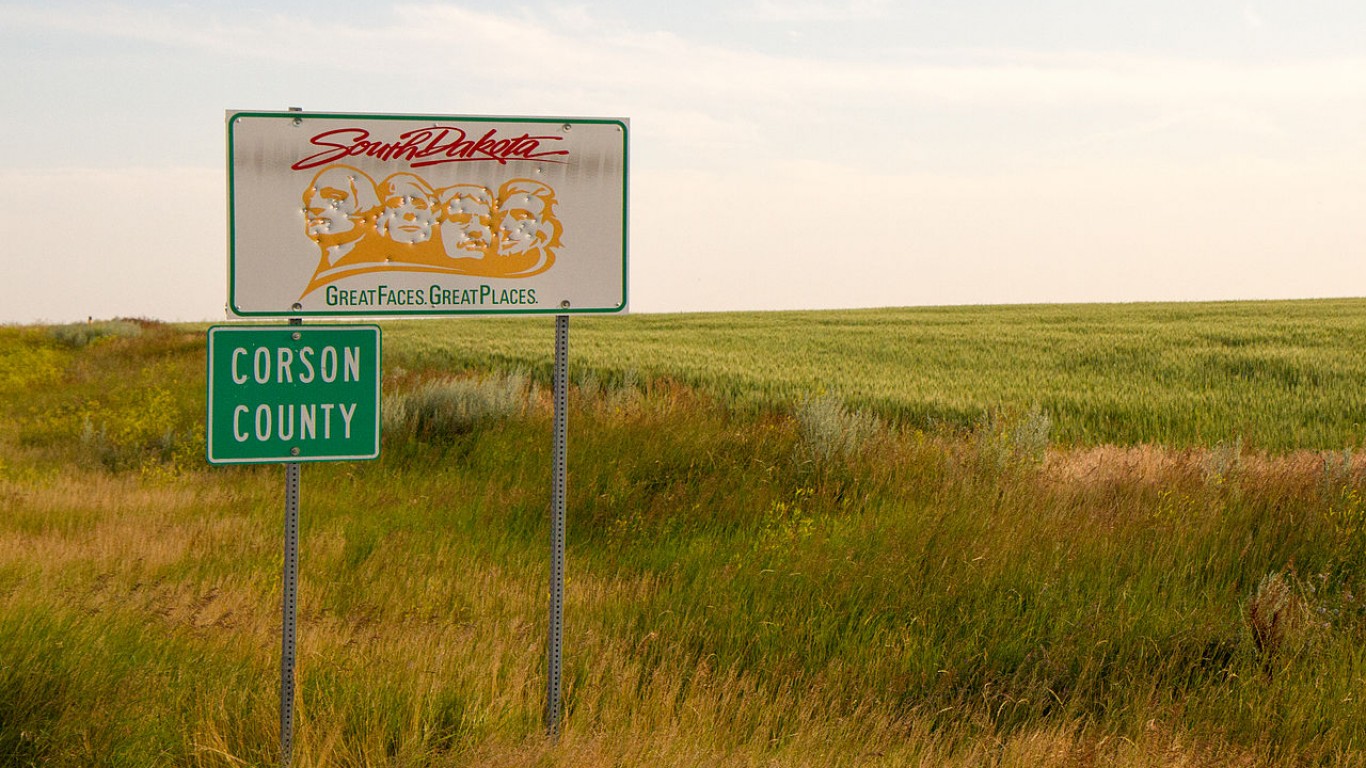
41. South Dakota: Corson County
> Median household income: $35,759 (state: $58,275)
> Poverty rate: 44.8% (state: 13.1%)
> Nov. 2020 unemployment: 4.0% (state: 3.3%)
> Adults with a bachelor’s degree: 17.8% (state: 28.8%)
> Largest place in county: McLaughlin
Corson County, South Dakota, is the poorest county in South Dakota with a median annual household income of $35,759 — well below the statewide median of $58,275. The county covers much of the Standing Rock Indian Reservation. Due to a wide range of historical and contemporary factors, Native American reservations are often economically depressed areas, and in Corson County, 44.8% of the population lives below the federal poverty threshold.
Low-income areas often have lower than average educational attainment rates. In Corson County, just 17.8% of adults have a bachelor’s degree or higher, compared to 28.8% of adults across South Dakota.
[in-text-ad]
42. Tennessee: Jackson County
> Median household income: $35,207 (state: $53,320)
> Poverty rate: 19.2% (state: 15.2%)
> Nov. 2020 unemployment: 5.6% (state: 5.0%)
> Adults with a bachelor’s degree: 11.0% (state: 27.3%)
> Largest place in county: Gainesboro
Jackson County is a relatively rural county in north central Tennessee not far from the Kentucky border. The poorest county in the state, more than half of all households earn less than $35,300 a year, and nearly one in every 10 households earn less than $10,000 annually. Across all Tennessee, the typical household earns $53,320 a year, and 6.9% of households earn less than $10,000.
As is often the case in low-income areas, adults in Tennessee’s poorest county are far less likely than most American adults to have a college education. Just 11.0% of Jackson County’s 25 and older residents have a bachelor’s degree or higher, compared to 27.3% of the adults in Tennessee.
43. Texas: Starr County
> Median household income: $30,387 (state: $61,874)
> Poverty rate: 34.7% (state: 14.7%)
> Nov. 2020 unemployment: 19.0% (state: 8.0%)
> Adults with a bachelor’s degree: 9.9% (state: 29.9%)
> Largest place in county: Rio Grande City
Starr County — located on the state’s southern tip, bordering Mexico — is Texas’ poorest county, with a median annual household income of $30,387, less than half the state median of $61,874. Out of over 3,000 U.S. counties, Starr is one of just a few dozen where fewer than 10% of the adult population have a bachelor’s degree. An estimated 9.9% of county residents 25 and over have a bachelor’s degree, compared to 29.9% of Texas residents.
Among Starr County’s roughly 64,000 residents, 34.7% earn incomes below the poverty line. The county’s poverty rate is the highest share in the state, one of the highest of any U.S. county, and well more than double the state poverty rate.
44. Utah: Wayne County
> Median household income: $44,245 (state: $71,621)
> Poverty rate: 9.6% (state: 9.8%)
> Nov. 2020 unemployment: 5.8% (state: 3.9%)
> Adults with a bachelor’s degree: 23.4% (state: 34.0%)
> Largest place in county: Loa
Utah’s Wayne County is home to part of the famous Canyonlands National Park in the southern half of the state. It is also the poorest county in the state, with a median annual household income of $44,245, far less than the state median of $71,621. While the county’s median household income is relatively low, it compares favorably to other low-income counties across the country by some measures. For example, the county’s poverty rate of 9.6% is actually slightly lower than the state poverty rate of 9.8% and well below the national poverty rate of 13.4%.
[in-text-ad-2]

45. Vermont: Essex County
> Median household income: $44,349 (state: $61,973)
> Poverty rate: 13.4% (state: 10.9%)
> Nov. 2020 unemployment: 2.8% (state: 2.8%)
> Adults with a bachelor’s degree: 16.2% (state: 38.0%)
> Largest place in county: Island Pond
Vermont’s Essex County, found in the northeastern corner of the state bordering both New Hampshire and Canada, is the state’s poorest. The county’s median annual household income of $44,249 is well below the state median of $61,973. Out of the county’s 6,200 residents, 13.4% earn incomes below the poverty line, compared to the state poverty rate of 10.9%.
As is often the case in low-income areas, adults in Vermont’s poorest county are far less likely than American adults to have a college education. While the state as a whole has a relatively high bachelor’s attainment rate among adults of 38.0%, just 16.2% of Essex County’s 25 and older residents have a bachelor’s degree or higher.

46. Virginia: Dickenson County
> Median household income: $29,932 (state: $74,222)
> Poverty rate: 25.7% (state: 10.6%)
> Nov. 2020 unemployment: 5.9% (state: 4.6%)
> Adults with a bachelor’s degree: 10.7% (state: 38.8%)
> Largest place in county: Clintwood
Virginia is a state characterized by income extremes. It is home to some of the wealthiest counties in the United States, especially Washington D.C.-neighboring counties. For example, Loudoun County’s median annual household income is $142,299, the highest of any U.S. county. The state is also some of the poorest places in the U.S. Virginia’s poorest county, Dickenson County, has a median annual household income of $29,932, more than $44,000 below the state median.
In Dickenson County, located all the way in the western part of the state and far from the nation’s capital, more than one in four of its roughly 15,000 residents earn incomes below the federal poverty level, compared to approximately one in 10 Virginians.
[in-text-ad]

47. Washington: Ferry County
> Median household income: $41,939 (state: $73,775)
> Poverty rate: 17.3% (state: 10.8%)
> Nov. 2020 unemployment: 8.2% (state: 5.9%)
> Adults with a bachelor’s degree: 18.8% (state: 36.0%)
> Largest place in county: Republic
Washington’s Ferry County is in the northeastern part of the state, partially bordering Canada. It is also the state’s poorest, with a median annual household income of $41,939, compared to the state median of $73,775.
The county contains part of the Colville Indian Reservation. Due to a number of historical and contemporary factors, Native American Reservations are often economically disadvantaged.
In Wayne County, 8.2% of the county’s labor force are unemployed, compared to 5.9% of the state labor force and the 6.4% national labor force.
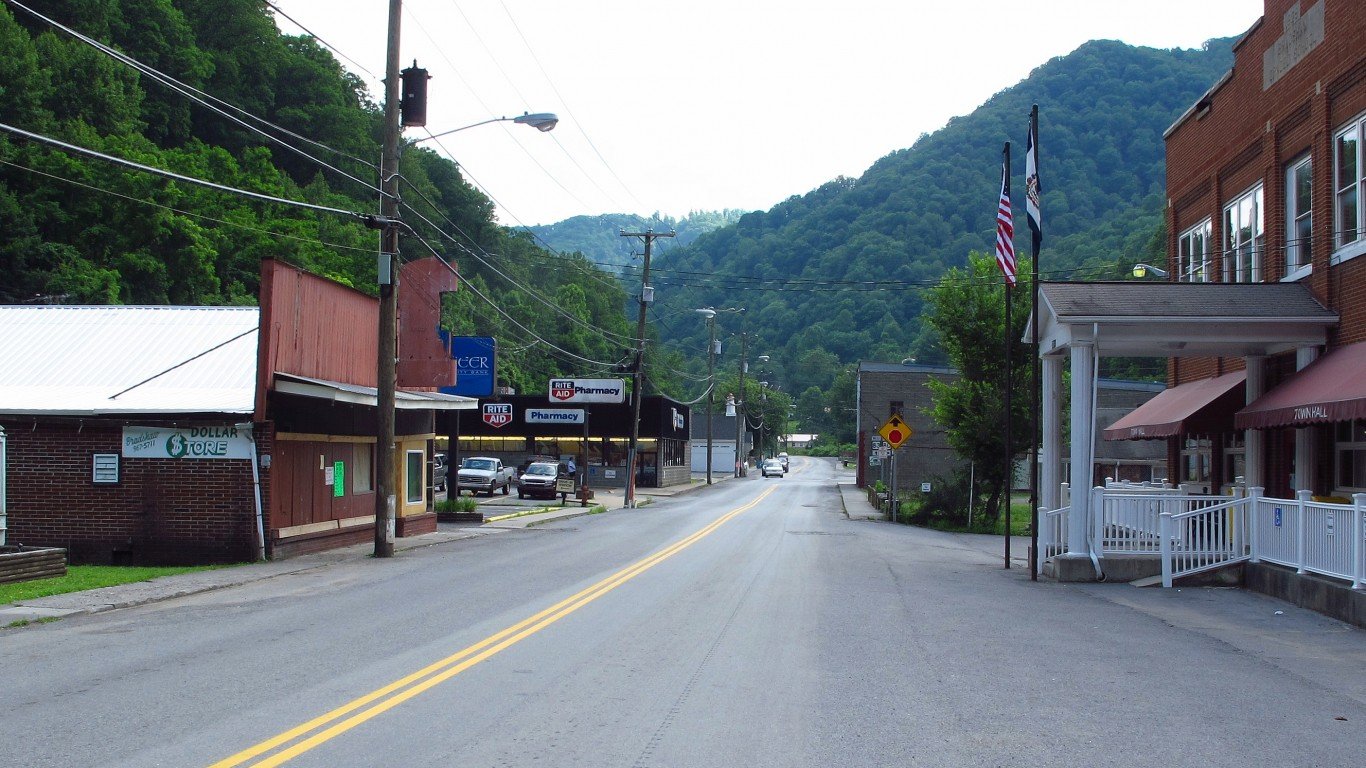
48. West Virginia: McDowell County
> Median household income: $27,682 (state: $46,711)
> Poverty rate: 33.2% (state: 17.6%)
> Nov. 2020 unemployment: 10.3% (state: 5.7%)
> Adults with a bachelor’s degree: 5.4% (state: 20.6%)
> Largest place in county: Welch
West Virginia is one of the poorest states in the country, with a median annual household income of $46,711, higher only than Mississippi. Even that figure is relatively high compared to the state’s poorest county. In McDowell County, the state’s southern county bordering Virginia, the typical household has an income of just $27,682 a year. In West Virginia, a relatively high 8.7% of households earn less than $10,000 annually. In McDowell, that share is 15.5%.
Low incomes are usually a symptom of poor economic conditions, including a weak job market. In McDowell County, 10.3% of the labor force was unemployed as of November, well above the state’s unemployment rate of 5.7% and one of the highest such rates of any county in the U.S.
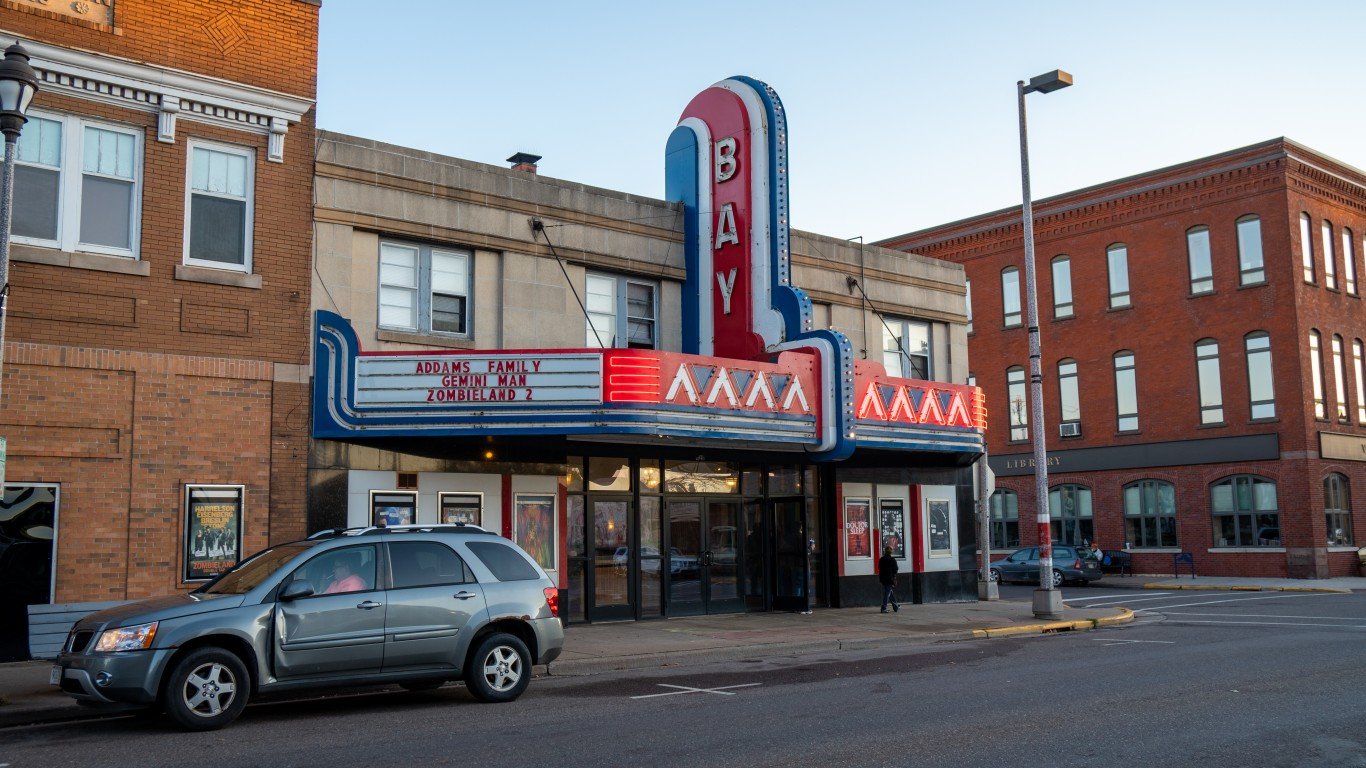
49. Wisconsin: Ashland County
> Median household income: $42,510 (state: $61,747)
> Poverty rate: 17.4% (state: 11.3%)
> Nov. 2020 unemployment: 6.4% (state: 4.5%)
> Adults with a bachelor’s degree: 19.8% (state: 30.1%)
> Largest place in county: Ashland
Wisconsin’s Ashland County is the state’s poorest, with a median annual household income of $42,510, compared to a state median of $61,747. Among the county’s 15,600 residents, 17.4% live below the poverty line, compared to 11.3% of state residents and 13.4% of Americans.
As is often the case in low-income areas, Ashland County, which is in the northernmost part of the state, on the border with Lake Superior, has a relatively low bachelor’s degree attainment rate. Just 19.8% of county residents age 25 and up have a four-year college degree, compared to the 30.1% share across Wisconsin.
[in-text-ad-2]

50. Wyoming: Albany County
> Median household income: $49,322 (state: $64,049)
> Poverty rate: 20.7% (state: 11.0%)
> Nov. 2020 unemployment: 3.0% (state: 4.9%)
> Adults with a bachelor’s degree: 51.8% (state: 27.4%)
> Largest place in county: Laramie
Wyoming’s Albany County, found in the southeastern part of the state on the border with Colorado, is the poorest in the state. The county has a median annual household income of $49,322, compared to a state median of $64,049. Over 20% of the county’s 38,390 residents earn incomes below the poverty line, compared to 11.0% of state residents. In Wyoming, 4.9% of households report annual incomes below $10,000, but in Albany County, 8.0% do.
Poor economic conditions, including limited job opportunities, often correspond with lower incomes, but Albany County’s 3.0% unemployment rate is lower than both the state unemployment rate of 4.9% and the national unemployment rate of 6.4%.
Methodology:
To identify the poorest county in each state, 24/7 Wall St. reviewed median annual household incomes for each U.S. county using five-year estimates from the U.S. Census Bureau’s 2019 American Community Survey. We only considered counties with income estimates with a maximum 10% margin of error.
We also reviewed in each county the percentage of adults who hold a bachelor’s degree or higher, the poverty rate, and median home value from the ACS. Unemployment rates for November 2020 are from the Bureau of Labor Statistics and are not seasonally adjusted.
County equivalents, such as parishes in Louisiana and boroughs in Alaska, were included in our analysis.
Sponsored: Want to Retire Early? Here’s a Great First Step
Want retirement to come a few years earlier than you’d planned? Or are you ready to retire now, but want an extra set of eyes on your finances?
Now you can speak with up to 3 financial experts in your area for FREE. By simply clicking here you can begin to match with financial professionals who can help you build your plan to retire early. And the best part? The first conversation with them is free.
Click here to match with up to 3 financial pros who would be excited to help you make financial decisions.
Thank you for reading! Have some feedback for us?
Contact the 24/7 Wall St. editorial team.

 24/7 Wall St.
24/7 Wall St. 24/7 Wall St.
24/7 Wall St. 24/7 Wall St.
24/7 Wall St.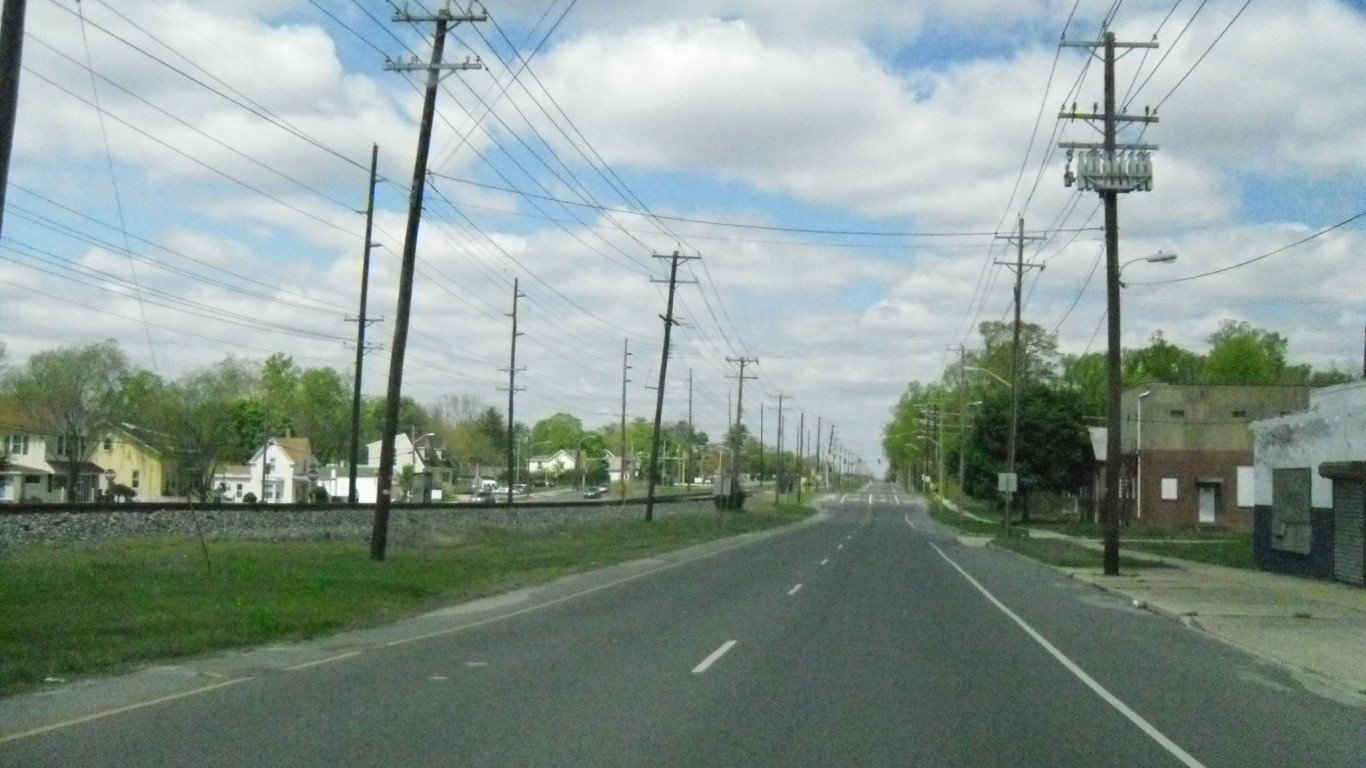
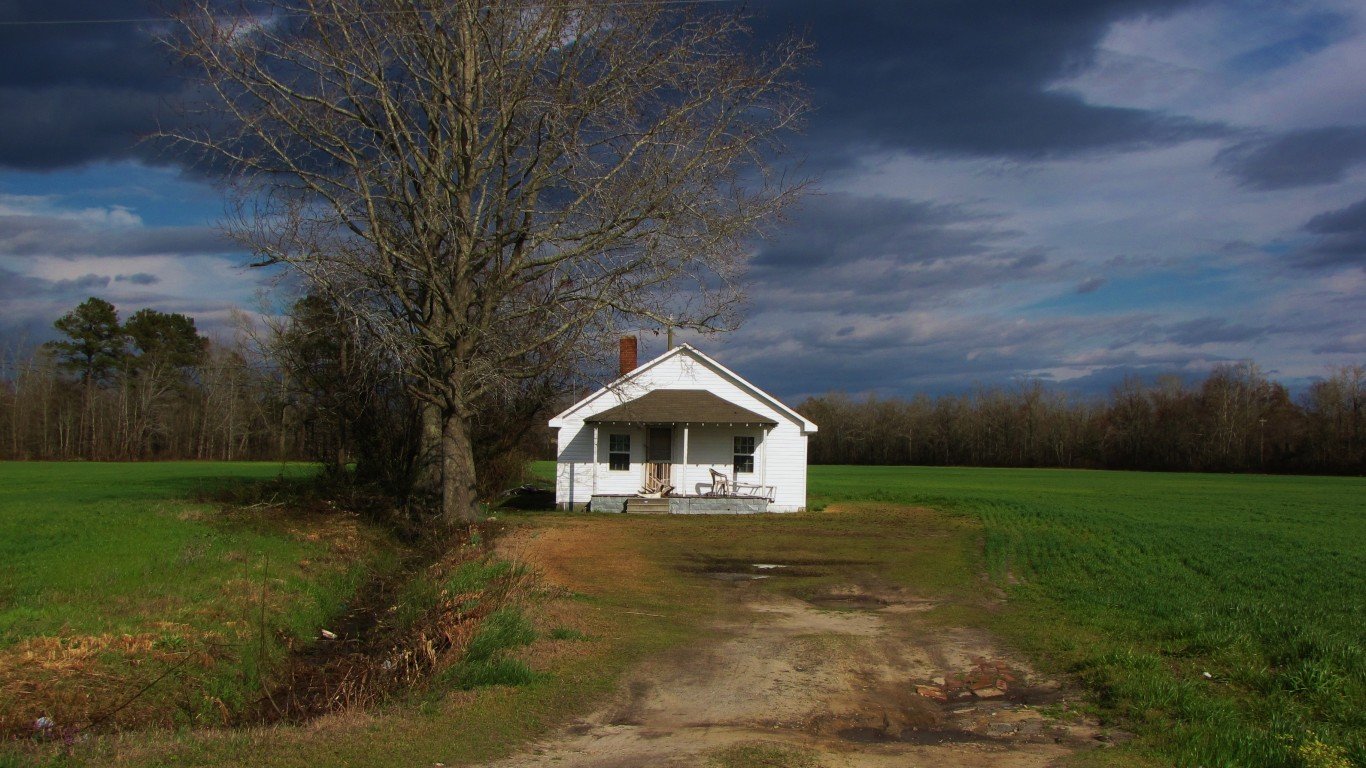
 24/7 Wall St.
24/7 Wall St.